#Scrap Processing Machine
Explore tagged Tumblr posts
Text
High-Efficiency Scrap Processing Machine | Intelligent Edge
Maximize your metal recycling efficiency with Intelligent Edge’s advanced Scrap Processing Machine. Engineered for durability and precision, our machine delivers superior performance in cutting, shredding, and compacting metal waste. Ideal for steel plants, recycling centers, and industrial operations, this robust solution reduces manual labor, boosts throughput, and ensures eco-friendly scrap handling. Trust Intelligent Edge for turnkey solutions that redefine sustainability and productivity in metal recycling.

#Scrap Processing Machine#Scrap Metal Shredder#Metal Recycling Machine#Industrial Scrap Shredder#Metal Waste Processing Equipment
0 notes
Text

#akudama drive#I hope nobody else did this before I did#well. nobody else would've included sniper so it's different regardless 😍#hacker would hack the machine#and courier would just walk away#but alas#those were not options#brawler would not only punch the vending machine#he would pick it up. toss it half a kilometer#and then pound it into scrap metal#destroying all the contents in the process
53 notes
·
View notes
Text
WARNING: The penalty for trespassing on the railway is £1000.
#here is the story of two researchers and one 0 on the truth table. here is how you almost tied up my arm in a belt#because you lost your tourniquet and neither of you could find my veins. did it feel good to get it off your chest#did it feel cathartic to talk about sin? in a room full of policymakers and experts i shook hands with a theoretical#physicist creating breathing metal. we talked about annual ruination. there is a boy in gold earrings#and two strangers growing a fake hologram with their minds. you discover you like wine and that you are#perhaps only a little bit cutthroat. here is a teapot full of tequila and a glance a curling of the lips that renders you [0]#first on the index and quickly overlooked. you want to be loved? here is the difficult bit. girl teaches you how to speak mandarin. still#too drunk to find your veins but here i want to be loved anyway. in a shocking turn of events the thing that keeps me alive#projected through my lovers noise cancelling headphones causes a slow peak in the 10 millisecond span i process#falling lights and yet increases accuracy to almost 87.5%. is it magic or are you just discussing your downfall?#the truth is have no skill or qualification to my name. i want you to listen to me. he said you will be a king. he said if a bomb#fell on this room everything that matters would be over. YOU WANNA LEARN ABOUT LOVE YOU SELFISH FUCKER? YOU SHOULD HAVE CHOSEN ME#WHEN YOU WERE 15. THE LOVE IS GONE IF YOU HAVE TO ASK IT. hes the alaskan#WHEN YOU WERE 15. THE LOVE IS GONE IF YOU HAVE TO ASK IT. i am the alaskan malmute under the dinner table begging for scraps#in a place im not supposed to be. in the field it was me with the drumsticks her (the world piano champion and the researcher and the#the machine gun) with the 巴乌 him with the guitar this is outside of london this is the ex presidents ex advisor telling you to give up#this is your brain and this is the day after doom. this is her washing the EEG conductive gel out of your hair in the restaurant bathroom#this is the skill to possess guilt without carrying shame.
5 notes
·
View notes
Note
Hello! I was wondering what company you use for your sticker sheets? I bough one from your Ko-Fi shop and really like the quality, and the pricing you were able to sell at is waaaaaay more reasonable compared to any of the companies I've seen and used myself. Is it a POD company, or a mass purchase of them to sell on your own?
Thank you for your time if you're able to respond!
I'm really glad you like the quality, because I actually make them by hand at home! (Please forgive the lighting, my bedroom is my office lmao.)
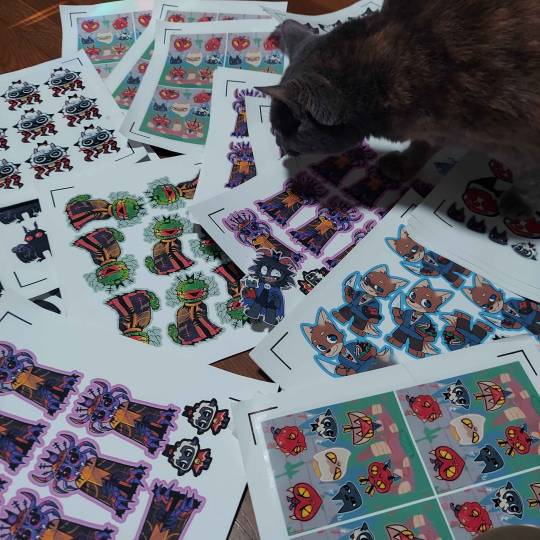
I don't use a company (and Idk what a POD company is sorry!) but making them at home gives a lot more freedom of stock, just be wary it can be very time consuming depending on how many you need to make.
I've had other people ask before, so here's a rundown of how I make my stickers at home: At most you'll need:
Printer
Sticker paper (this is the type that I use)
Laminator and lamination paper (the lamination paper that I use.) You can also use adhesive non-heat lamination paper if you don't have a laminator, gives you the same result, just be careful of bubbles. You will get double your worth out of a pack because we are splitting the pouches to cover two sticker sheets.
Your choice of a sticker cutting machine or just using scissors.
First, I use Cricut's software to print out the sticker sheet with the guidelines around the corners so the machine can read it. If you do NOT have a Cricut machine, open up your art program, make a canvas of 2550x3300 and fill it up with your sticker design with some cutting space between them. This the 8.5x11 size for the sticker page.
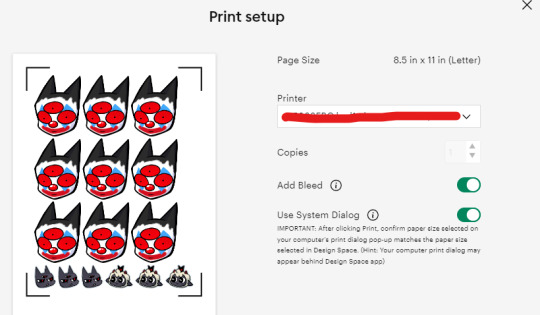
I usually have bleed selected so the cut comes out cleaner. Tip for non-Cricut users below: Increase the border around your sticker design to fake the 'bleed' effect for a cleaner cut.
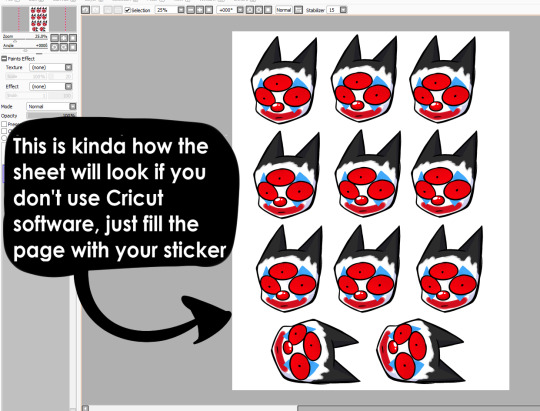
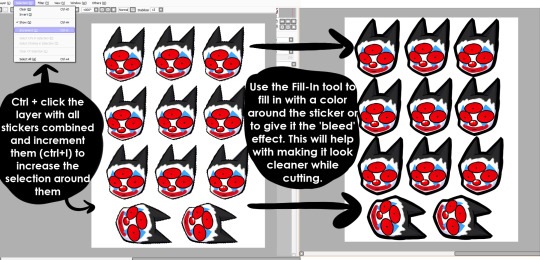
These are the print settings I use for my printer. I use the 'use system dialogue' to make sure I can adjust the settings otherwise it prints out low quality by default. Make sure if you're using the above paper that you have 'matte' selected, and 'best quality' selected, these aren't usually selected by default.
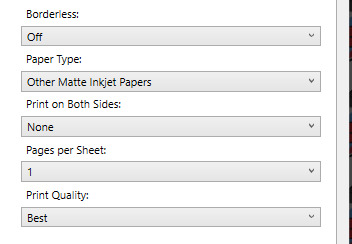
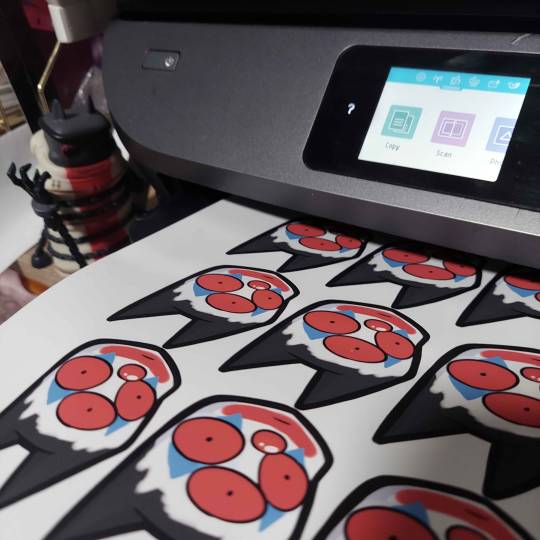
So you have your sticker sheet printed! Next is the lamination part. I use a hot laminator that was gifted to me, but there is no-heat types of lamination you can peel and stick on yourself if that's not an option.
(This is for protection and makes the colors pop, but if you prefer your stickers matte, you can skip to the cutting process.)
Important for Cricut users or those planning to get a Cricut: You're going to cut the lamination page to cover the stickers while also not covering the guidelines in the corners. First, take your lamination page and lay it over the sheet, take marker/pen and mark were the edges of your stickers are, and cut off the excess:
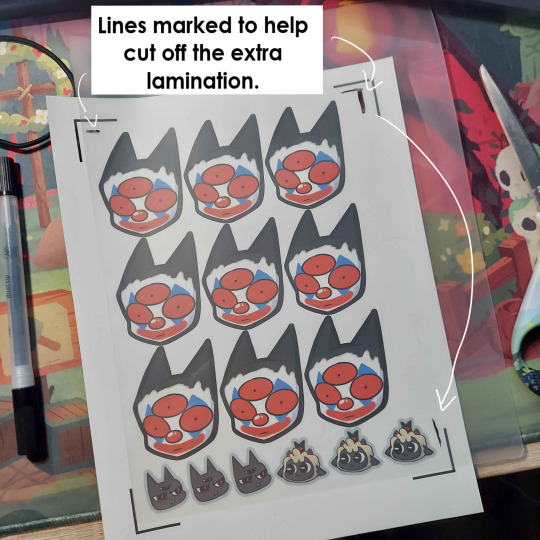
(I save the scrap to use for smaller stickers or bonuses later on)
After you've cut out your lamination rectangle, separate the two layers and lay one down on your sticker sheet over your stickers with matte side down, shiny side up. (Save the other sheet for another sticker page)
The gloss of the lamination will prevent the machine from reading the guidelines, so be careful not to lay it over them. It also helps to cut the corners afterwards to prevent accidentally interfering with the guidelines.
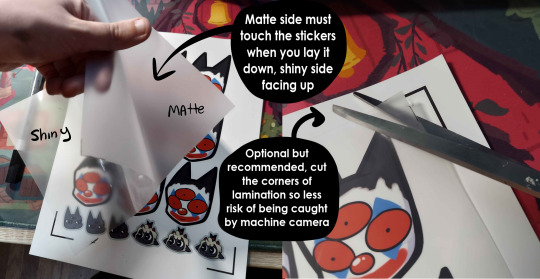
Now put that bad boy in the laminator! (Or self seal if you are using non-heat adhesive lamination)
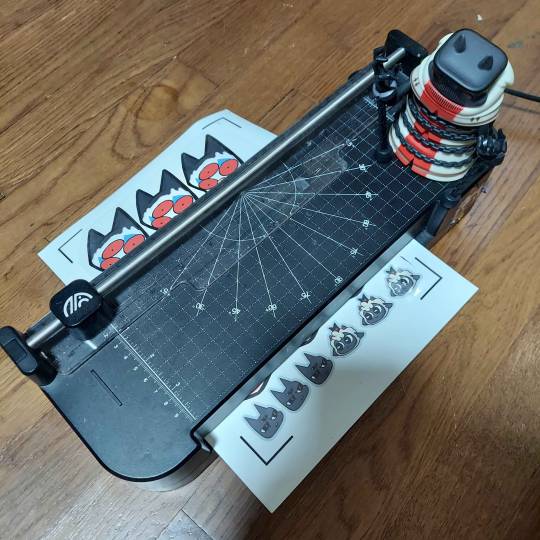
Congrats! You now have a laminated page full of stickers.
For non-cricut/folks cutting them out by hand: this is the part where you start going ham on the page with scisscors. Have fun~
Cutting machine: I put the page on a cutting mat and keep it aligned in the corner, and feed it into the machine. For laminated pages I go between 'cardstock' and 'poster board' so that it cuts all the way through without any issues, but for non-laminated pages or thinner pages, I stick for 'vinyl' and 'light card stock'. Kinda test around.
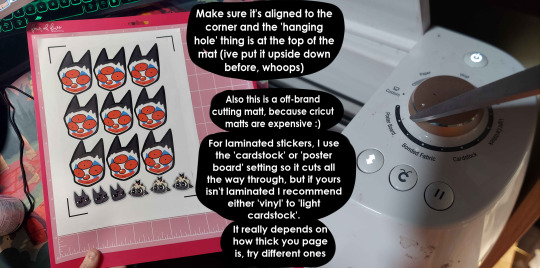
Now I smash that go button:

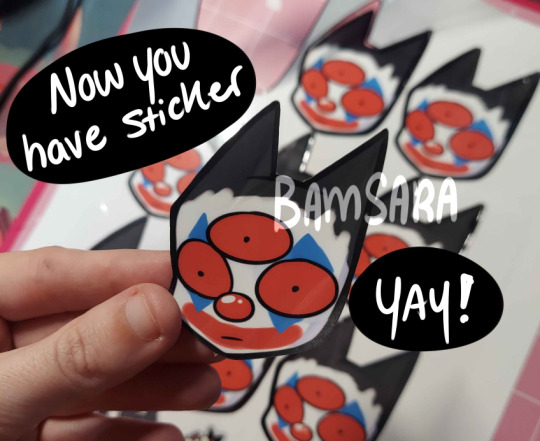
You have a sticker now!
The pros of making stickers at home is that you save some cost, and you have more control of your stock and how soon you can make new designs. (I can't really afford to factory produce my stickers anyway)
However, this can be a very time consuming, tedious process especially if you have to make a lot of them. There is also a LOT chance for some errors (misprints, miscuts, lamination bubbles, ect) that will leave you with B-grade or otherwise not-so-perfect or damaged stickers. (Little note, if you have page mess up in printing and can't be fed into the cricut machine, you can still laminate it and cut it out by hand too.)
I have to do a lot of sticker cutting by hand, so if you don't have a cricut don't stress too much about it. I have an entire drawer filled to the top of miscuts/misprints. I keep them because I don't want to be wasteful, so maybe one day they'll find another home. Sucks for my hand though.
But yeah! This is how I make my stickers at home! Hope this is helpful to anyone curious
1K notes
·
View notes
Text
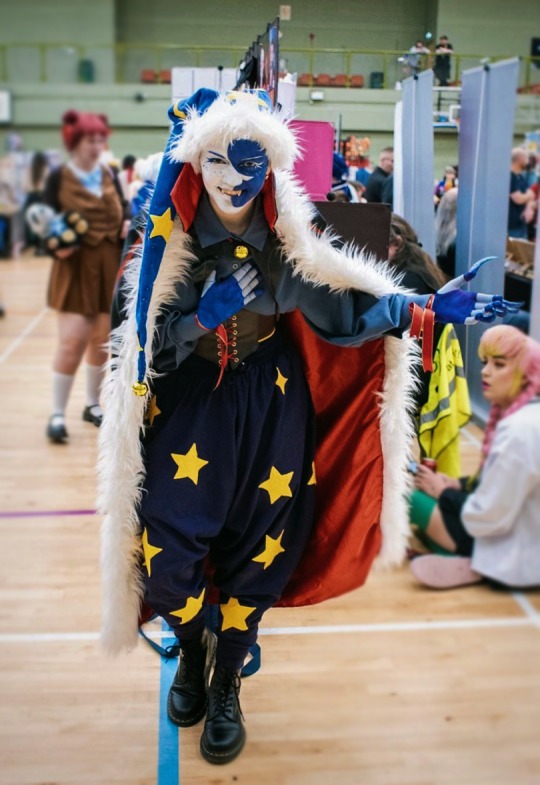
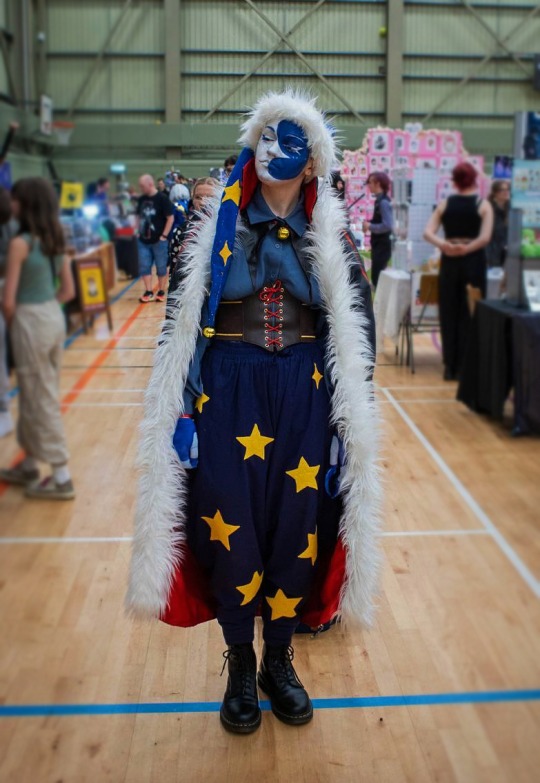
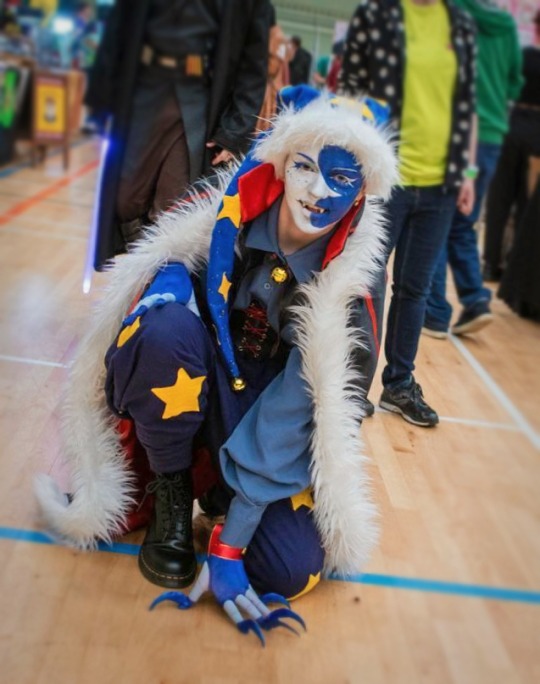
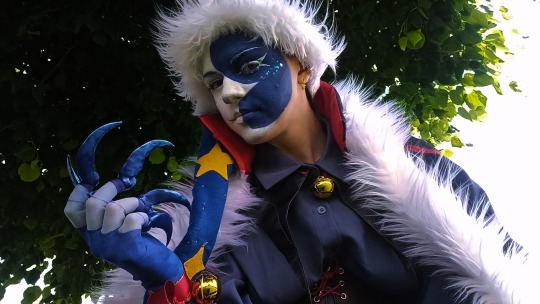
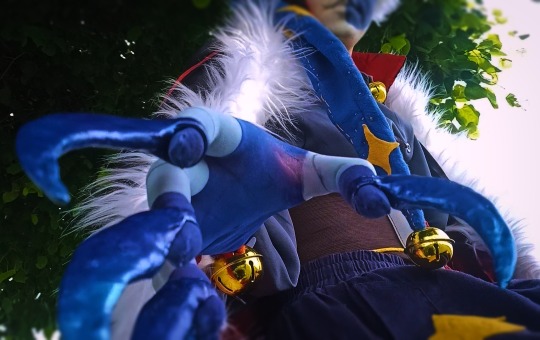
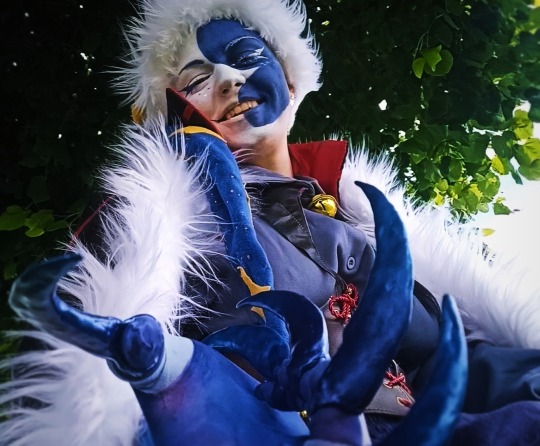
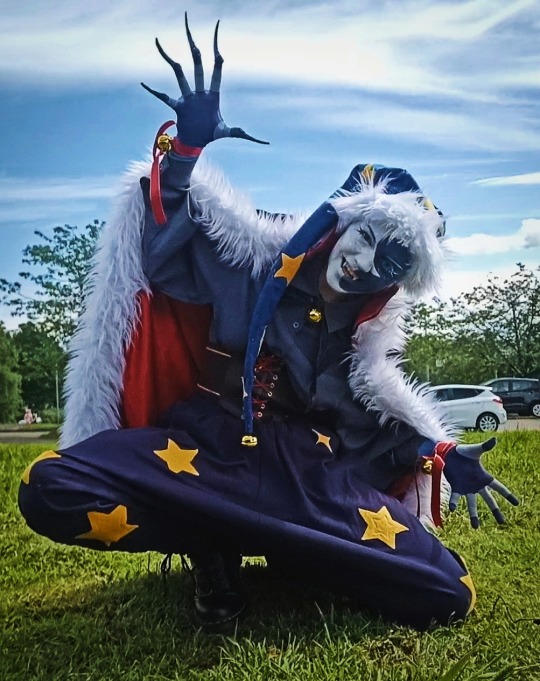
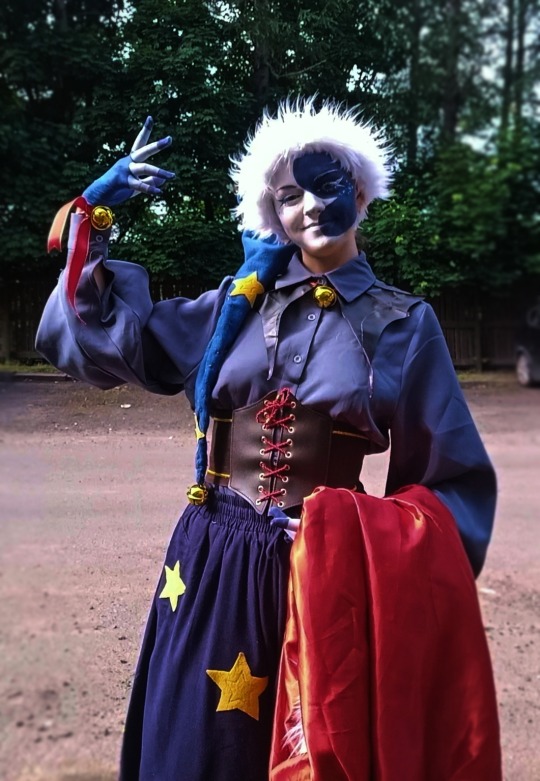

My first ever comic con! And first cosplay too. Of course it's gonna be my boy :] Ramblings about the process are under the cut(Let me know if?? You would want me to elaborate with process images for any of the steps?)
The costume took me forever to make, as I've never done any machine sewing, sculpting, fabric dying or spray painting before but learning all of these was so fucking fun!! I never realised just how many different skills go into making a cosplay but it was so worth it!!!
Almost all of the clothes(except the hat) were purchased first as bases, but all of the detailing was added by me. All of the fabric used was originally just scraps that I was given for free so I needed to learn how to dye and dye all of the stars, they were originally white.
The sewing machine was its own beast that brought me tons of frustration from the lack of skill and knowledge (it was devastating to find out that 95% of fuck ups were my fault and not the machine's lmao). But as a result, a hat sewn from scratch, all of the fur trims, embroidery on the corset, stars and the collar(which is very hard to see on the pictures unfortunately) was all added manually. The stars and the stripes(on the back of the cape) were attached using heat-and-bond adhesive (I WISH I knew about such thing just when I started working on this. It would save me so much time and nerves.)
Then I found out about polymorph(mouldable plastic) and it has become the next thing I wanted to learn, to sculpt the claws and the fangs(yes, they're handmade jfksjs). The claws I then primed and painted in trillion coats because I wasn't satisfied with the colour of the spray paint. The fangs I moulded to my own teeth and then stained with tea to match the colour of my teeth :)c
As for makeup, I used Mehron Paradise water activated paints. At first I wanted to try to save money and bought myself Snazaroo instead, which unfortunately turned out to be a waste. Snazaroo didn't hold on my face for longer than 2 hours, cracking and peeling awfully. Mehron on the other hand survived 11 hours of me smiling, talking, emoting and such and didn't even crease at the smile lines(I'm actually shocked about that). It obviously works like any other makeup which means your skin texture and wrinkles won't go anywhere but Mehron's elasticity pleasantly surprised me. It did obviously smear from sweat and saliva(if you're eating and licking your lips) but if you don't touch the skin it just dries again, self setting. But if it's dry it's fully smear-proof. Highly recommend!
And last but not least, I've decided against painting my hands as it was very risky that I will stain everything I touch at the smallest hint of sweat. So instead I got myself gloves-tights(? Not sure how they're called but it's made from the same fabric as tights) and painted them with normal acrylic paint(did you know you could dye fabric with acrylic paint? I personally didn't), then heat set with an iron and voilà, they're reusable, my hands are not stained after an exhausting day and I don't stain everything I touch. It worked wonderfully which honestly was a surprise as I was really sceptical that acrylic paint will somehow stay in place.
I think this whole thing took me minimum of 6 months with big-big breaks for my school and life in general. But I'm really proud! This project taught me so many new skills and I couldn't have been happier about learning new knowledge, even if it sucked to fail in the meantime.
Everyone at the con was really nice and gave me a large confidence boost even tho it was my first time and I had no idea what I was doing. Taking photos with other people was really awkward/new for me as I hate cameras so I really had no idea how to pose/behave in front of one. But that's okay I think. This whole experience definitely made me want to do this again, so I think that will come with experience. Thank you for reading this far, hope you enjoyed this little summary :)
#my art#cosplay#biting the hand that feeds au#moondrop#fnaf moondrop#fnaf moon#moondrop fnaf#moon fnaf#bhtf moondrop#i had such a good time#little awkward moments of me being autistic and not reading social cues and/or having trouble processing didn't go anywhere#but that's okay#i don't think i was ever complimented as much as i was complimented at the con so that's a W#artist alley was definitely an experience of me just finding out how actually autistic i am#because i really Am Not Interested in anything aside from my special interests#literally got myself a singular Moon sticker and a singular Mothman print#that's it lmfaooo#i also had people come up to me to just give me a tiny plastic newborn toy and run away#10/10 hilarious#bhtf au#i MIGHT just draw Moon in some of those poses because 👀#also maybe will make a separate post just showing off all of the details that are not as noticeable on camera? maybe? if yall would want#the cape and the hat ARE SO FUCKING FLUFFY#thank you silvermizuki for the fur🫵
2K notes
·
View notes
Text
"hank.. what am i feeling right now?"
˚₊· ͟͟͞͞➳❥ connor anderson (rk800) x officer!reader

sypnosis ; connor is very interested in an officer who just joined the police force. after being told the news that they would be joining the team, connor just had to make an acquaintance with them. anything to hear their voice.
containing ; use of you/yours and they/them pronouns! connor struggling to process emotions. hank being a proud father.
author’s note ; hihi! havent written for connor in SO long so i thought this was a cute little way of them meeting each other.
04.12.24 | 1.9k words
-ˋˏ✄┈┈┈┈
Everyone knew about the infamous RK800.
The last most developed and intelligent android produced by Cyberlife.
A machine built to hunt its prey and to always accomplish his mission.
But now?
A confused man sitting at his desk, elbows on the surface as he ran the fourth diagnostic this morning.
Connor was never really taught how to feel his emotions, considering that he was forced to compress them from the moment he was made. If he were to feel any sort of emotion, it was either to the scrap factory for him or a hard lecture from Amanda.
But Amanda was gone, and androids were free to express any emotion they pleased.
It’s been weeks since Markus hit the headlines for his famous android revolution. He worked with the government extensively to pass bills in order to settle android rights for the country. Connor, on the other hand, continued to work with the DPD as a full-on detective under the supervision of Liutenant Hank Anderson. Hank was more than just a coworker, but a father figure to Connor. And that brought Connor joy, an emotion Connor was well aquainted of.
But not the feeling he was experiencing now.
Connor couldn’t get his mind off a certain someone who had joined the team a bit before the revolution. You had joined a week prior, and honestly, you were kind of regretting it. As android and human tensions rose, you were on duty 24/7. Originally, you were supposed to start easy with basic patrol around a part of a city, but because you were so impatient in doing the “big kid stuff” you found yourself frequently in the middle of the android and human discourse. Your shifts nearly lasted twelve hours, and you would be absolutely exhausted.
Things are different now. Sure, there were still some situations between the two sides, but it was definitely peace compared to literal boycotts. You sat at your desk idly scrolling through your past cases, making sure that all the information was correct and accurate. On the other side of your desk was a tablet full of notes you had taken after some cases you had to deal with. What you didn’t notice was the android detective constantly glancing at you, watching your every move to see if maybe, at some point, you would notice him.
A loud groan echoing from the desk in front of Connor made him jump, immediately turning his attention to his lieutenant taking a seat in his chair. “Fucking hell..” Hank sighed. “Fowler does nothing but my bust my balls these days, huh?” Connor stared at his partner with his hands folded in his lap and eyebrows furrowed.
“Is everything okay, Lieutenant?” Connor asked, tilting his head.
“It’s nothing too serious. Fowler just wants me to take the rookie on our next homicide case. He insisted that they would be a perfect addition to the team or whatever.” Hank groaned. “Now I’m responsible for two of you fucks.”
Connor, admittedly, felt his thirium pump racing. You? As part of the team? It was almost like he could overheat and shutdown momentarily right now. “I think they would be a great addition to the team.” Connor stated, biting back from smiling. “They have an excellent track record of solving cases in an orderly and timely manner, has caught every perpretrator with their undercover skills, and had a reputation back in their training classes as one of the top students.” He explained. Hank looked over as he was slouched in his seat with arms folded across his chest.
“Jesus, Connor, you sound like some creep searching up their name on Google.” Hank scoffed, half smiling. Though this caught Connor a little off— was he being creepy? He didn’t want to leave a bad impression on you, especially now that you're about to meet for the first time. His face scrunched up in anxiety, feeling as if he made a mistake. Hank immediately took notice and sat up. “Ah— I was just joking, Connor. I’m sure you have uh.. Good intentions.” Hank reassured, though he never said he was exactly good at it.
Hank looked over to you, seeing that you were preoccupied with work despite the fact you haven’t been on a case in a few days now. Hank looked at Connor. “Well.. Why don’t you introduce yourself to them.” Hank suggested, nodding his head over to you.
Connor immediately jolted his head up, a little wide-eyed to even suggest such. “O-Of course.” Connor stuttered out. Connor never stuttered, and though Hank was in a mood after his exchange with Fowler, he certainly didn’t leave that unnoticed.
“Did you just stutter?” Hank asked, a little amused. “Are you.. Nervous?”
“Of course not, Lieutenant,” Connor replied as steadily as possible. “I am an android.”
“Connor.”
“Yes?” Connor replied, mindlessly.
“You’re a deviant, for fucks sake.”
“Oh.”
Connor, to avoid anymore embarassment from the man he deemed his father figure, swiftly got up and started to approach you. Hank watched in pure amusement, not even wanting to stop the boy from probably embarassing himself even further, but at least Hank had some faith in him. He is Detroit’s best god damn detective.
“Hello, Officer (l/n). My name is Connor. It is nice to meet you.” Connor said, putting his hand out for a shake. You looked up from your computer screen only to be met with the most chocolate eyes you’ve ever had the privilege of being in the prescence of. He smiled politely, but behind that smile he thanked Elijah that androids could not sweat, otherwise you would’ve felt the claminess of his palm.
You took his hand and shook it firmly. “A pleasure to make your aquaintance. My name is (y/n).” You smiled generously, and wow, did Connor felt like his pump couldn’t get any faster.. He cleared his throat before darting his eyes to the unoccupied chair that sat next to your desk.
“May I?” Connor asked, gesturing towards the seat.
“Of course, I’m not doing much anyway.” You nodded. Connor took a seat, and for some reason, he struggled to even maintain his balance as he sat himself down. He nearly had to think about how to fold his hands before placing them firmly on his laps and looking at you. Thankfully, you barely realized any sort of struggle as you looked away to take a swig of your morning coffee.
“So..” you said, clasping your hands. “Am I in trouble or anything?” you joked. Connor immediately shot his head up, worried he had made the wrong impression.
“Oh, no— I—” Before Connor could sputter out an explanation, you tilted your head a little and started laughing.
“Relax! I was just kidding!” You playfully waved off. Connor’s shoulders immediately relaxed as a breath he didn’t even know he was holding back escaped his lips. You looked at him curiously, a smile still resting on your face.
“I’m sorry. Usually, I am not like this.” He said, shaking his head a little in embarassment. He was always on his A game and constantly prepared. Why were you the reason for this disruption. “I.. Uh..” He couldn’t think of anymore to say. Suddenly, he got a message through his LED.
NEW MESSAGE:
HANK: tell them u think theyre pretty.
Connor blinked a bit, registering the text message. Hank was at a perfect view watching this unfold. The back of your head was visible but he could see all of Connor’s reactions, who desperately tried to maintain a polite smile.
“I think you’re very pretty, (y/n).” Connor complimented.
“Oh— ah—” A subtle blush began to form on your cheeks as your eyes widen a little, not expecting a compliment from a handsome android such as Connor. “Why thank you, Connor. I wasn’t expecting that as our first conversation.” You chuckled a little. “You’re not too bad yourself.”
Thirium was rushing through his circuits and to his cheeks. The faintest color of blue appeared dusted on his face. “Thank you.” He maintained a calm, neutral voice. They stared at each other for a minute, sort of registering the sort of corny first conversation the two of you had.
“Ah.. I almost forgot to mention.” Connor snapped back to reality. “I came here to introduce myself sfter I heard that you were joining our team on our next investigation. It’s good to make an aquaintance with our future team member.” Connor smiled politely.
“Why thank you. I am very excited to work with you and Lieutenant Anderson.” You nodded. “Though I will miss working with Gavin and Chris’ team.”
Ah, that’s right. You used to work with Gavin. It almost left a bad taste in Connor’s mouth knowing that Gavin probably spat some awful opinions about him to you. Though from the looks of it, you were enjoying your conversation with him which eased him.
“I promise we will a provide a welcoming and safe space in our team, and of course, to make sure you don’t come into harms way.” Connor assured. Though he was mainly promising this to you personally. God forbids Connor seeing you get hurt.
“Why thank you, Connor.” You said, tilting your head. Connor was rather intriguing to you— an android acting this way around you. His LED constantly switched between yellow and blue as if he was making sure to process every word you uttered. Yet he was so human— he would scratch the back of his neck, fidget with his fingers, and shuffle a bit in his seat. You would think someone as advanced as him would at least be able to have a composure, but he was different. It was something you admired about him.
“(l/n), in my office!” Captain Fowler called from the balcony of his room. You looked over to Connor before sighing.
“Well, boss is calling me. I’ll talk to you afterwards?” You suggested as you stood from your seat.
“Of course.” Connor replied, shielding his excitement. He stood up from his chair as well. “I’d be happy to talk again, (y/n).”
“Likewise.” You winked. With that, you left your desk and headed straight to Fowler’s office. Connor stood shellshocked. Did you just.. Wink at him?! Connor’s eyes slowly drifted to Hank, who was chuckling heartily. He gave Connor an assuring thumbs up as Connor made his way back to their desks.
“You’d be a shit detective if this is how you acted all the time.” Hank snickered. Connor grinned a little before taking a seat back at his desk.
“I know.” Connor sighed, leaning a little back in his chair. He at you through the glass walls, noticing your upright posture and the way you listened intently to Captain Fowler’s words. He looked over to Hank before thinning his lips.
“Lieutenant?” Connor asked.
“What is it, son?”
“What am I.. Feeling right now?” Connor asked, a little lost on how to explain it. “I can only think about them— only envision them when I close my eyes. I get nervous and its like my programming has reduced to 0s and 1s.” He sighed, hell, even a little frustrated that you had this affect on him.
Hank with a wide smile, shook his head and looked at Connor with a knowing stare. Connor looked up, both lost while desperate for an answer and maybe even a cure. Hank sat up and made sure to look at Connor right in the yes.
“Connor,” Hank sighed, grinning. “Son, that feeling your experiencing is called love. And your plastic ass better get used to it.”
-ˋˏ✄┈┈┈┈
thank you so much for reading towards the end ! im sorry if its a little messy-- i quickly had to post this before hanging out w some friends but i just wanted to get this out of the way rq! reblogs, replies, and even likes are so so appreciated <3
#detroit become human#connor detroit become human#connor x reader#connor x you#connor rk800#connor dbh x reader#dbh connor#dbh rk800#rk800 x reader#dbh#detroit become human fanfics#hank anderson#connor anderson#4k800#connor 4k800 x reader#dbh 4k800#4k800 x reader
2K notes
·
View notes
Text
i finished phase 3 of my dads old jeans ive been turning into patchpants, felt like it lacked in practicality so i added some pockets and loops for holding my stuff. top pic to demonstrate what it can hold


this pair is a personal challenge, i do not really like this shade of jeans but i wanted to see if i could make something out of it regardless, without immediatly going for fabric dye. (altho i used fabric dye for the fishbone so i failed there lol)
description plus photos of the process are under the cut if youre interested

i always start with a sketch to visualize what i want to make


i fully used scraps for this project, i pinned together a base and sewed that together, then added the pockets and loops. i machine sewed this altho you could also do it by hand, if you have the patience for that.
i only sewed this onto the pants afterwards, to make working on it easier, make sure you check while youre working if everything still fits where you want it to go
if you have more questions lmk!
485 notes
·
View notes
Text
Dragon Age: The Veilguard: Strangled by Gentle Hands
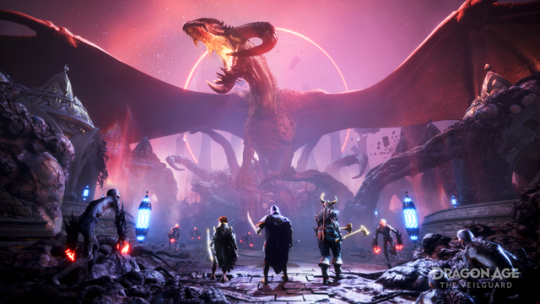
*The following contains spoilers*
“You would risk everything you have in the hope that the future is better? What if it isn’t? What if you wake up to find the future you shaped is worse than what was?”
– Solas, Dragon Age: Inquisition (2014)
I. Whatever It Takes
My premium tickets for a local film festival crumpled and dissolved in my pants pocket, unredeemed as they swirled in the washing machine. Throughout that October weekend in 2015, I neglected my celebratory privileges, my social visits to friends, and even my brutal honors literary theory class. All because a golden opportunity stretched before me: a job opening for a writing position at the once-legendary BioWare, with an impending deadline.
The application process wasn’t like anything I’d seen before. Rather than copy+paste a cover letter and quickly swap out a couple of nouns here and there, this opening required me to demonstrate my proficiency in both words and characters – namely, BioWare’s characters. Fanfiction wasn’t normally in my wheelhouse – at the time, I had taken mainly to spinning love sonnets (with a miserable success rate). But I wouldn’t balk at this chance to work on one of my dream franchises – especially since the job prospects for fresh English BAs weren’t exactly promising. So, I got to work crafting a branching narrative based on the company’s most recent title: Dragon Age: Inquisition. Barely two months prior, I saw the conclusion of that cast’s story when the Inquisitor stabbed a knife into a map and swore to hunt her former ally, Solas, to the ends of the earth. Now it was my turn to puppeteer them, to replicate the distinct voice of each party member and account for how they’d react to the scenario I crafted. And if it went well, then maybe I’d be at the tip of the spear on that hunt for Solas. Finishing the writing sprint left me exhausted, but also proud of my work.
The folks at BioWare obviously felt differently, because I received a rejection letter less than a week later. Maybe they found my story trite and my characterization inaccurate, or maybe they just didn’t want to hire a student with no professional experience to his name. Regardless, I was devastated. It wouldn’t be until years later that I learned that, had my application been accepted, I likely would’ve been drafted into working on the studio’s ill-fated looter shooter, Anthem (2019), noteworthy for its crunch and mismanagement. My serendipitous rejection revealed that sometimes the future you strive to build was never meant to match your dreams. What seemed like an opportunity to strike oil actually turned out to be a catastrophic spill.
Still, my passion for the Dragon Age series (as well as Mass Effect) persisted in the face of BioWare’s apparent decline. I maintain that Inquisition is actually one of the studio’s best games, and my favorite in the series, to the point where I even dressed up as Cole for a convention one time. The game came to me at a very sensitive time in my life, and its themes of faith vs falsehood, the co-opting of movements in history, and the instability of power all spoke to me. But I will elaborate more on that at a later date. My point is, I held on to that hope that, in spite of everything, BioWare could eventually deliver a satisfactory resolution to the cliffhanger from their last title. Or perhaps it was less hope and more of a sunk cost fallacy, as an entire decade passed with nary a peep from Dragon Age.
As years wore on, news gradually surfaced about the troubled development of the fourth game. Beginning under the codename “Joplin” in 2015 with much of the same creative staff as its predecessors, this promising version of the game would be scrapped two years later for not being in line with Electronic Arts’s business model (i.e. not being a live-service scam). Thus, it was restarted as “Morrison”. The project cantered along in this borderline unrecognizable state for a few years until they decided to reorient it back into a single-player RPG, piling even more years of development time onto its shaky Jenga tower of production. Indeed, critical pieces were constantly being pulled out from the foundations during this ten year development cycle. Series regulars like producer Mark Darrah and director Mike Laidlaw made their departures, and the project would go on to have several more directors and producers come and go: Matthew Goldman, Christian Dailey, and Mac Walters, to name a few key figures. They eventually landed on John Epler as creative director, Corinne Busche as game director, and Benoit Houle as director of product development. Then came the massive layoffs of dozens of employees, including series-long writer Mary Kirby, whose work still made it into the final version of DA4. Finally, the game received a rebranding just four months before release, going from Dreadwolf (which it had been known as since 2022) to The Veilguard (2024) – a strange title with an even stranger article.
Needless to say, these production snags did not inspire confidence, especially considering BioWare’s been low on goodwill between a string of flops like Anthem and Mass Effect: Andromeda (2017) and, before that, controversial releases like Dragon Age II (2011) and Mass Effect 3 (2012). The tumult impacted The Veilguard’s shape, which scarcely resembles an RPG anymore, let alone a Dragon Age game. The party size is reduced from four to three, companions can no longer be directly controlled, the game has shifted to a focus on action over tactics a la God of War (2018), the number of available abilities has shrunk, and there’s been a noticeable aesthetic shift towards a more cartoonish style. While I was open to the idea of changing up the combat (the series was never incredible on that front), I can’t get over the sensation that these weren’t changes conceived out of genuine inspiration, but rather vestigial traces from the live-service multiplayer iteration. The digital fossil record implies a lot. Aspects like the tier-based gear system, the instanced and segmented missions, the vapid party approval system, the deficit of World State import options, and the fact that rarely does more than the single mandatory companion have anything unique to say on a quest – it all points to an initial design with a very different structure from your typical single-player RPG. The Veilguard resembles a Sonic Drive-In with a mysterious interior dining area – you can tell it was originally conceived as something else.1
That said, the product itself is functional. It contains fewer bugs than any previous game in the franchise, and maybe BioWare’s entire catalog for that matter. I wouldn’t say the combat soars, but it does glide. There’s a momentum and responsiveness to the battle system that makes it satisfying to pull off combos and takedowns against enemies, especially if you’re juggling multiple foes at once. Monotony sets in after about thirty or forty hours, largely due to the fact that you’re restricted to a single class’s moveset on account of the uncontrollable companions. Still, this design choice can encourage replay value, as it does in Mass Effect, and free respec options and generous skill point allocations offset the tedium somewhat.
While the character and creature designs elicit controversy – both for the exaggerated art direction and, in the case of demons and darkspawn, total redesign – the environmental art is nothing short of breathtaking. I worried that this title would look dated because of how long it had been in development and the age of the technology it was built upon. Those fears were swiftly banished when I saw the cityscapes of Minrathous, the cyclopean architecture of the Nevarran Grand Necropolis, or the overgrown ruins of Arlathan. But like everything in The Veilguard, it’s a double-edged sword. The neon-illuminated streets of Docktown, the floating citadel of the Archon’s Palace, and the whirring mechanisms of the elven ruins evoke a more fantastically futuristic setting that feels at odds with all three previous titles (even though all three exhibited a stylistic shift to some extent). It aggravates the feeling of discordance between this rendition of Thedas and the one returning players know.
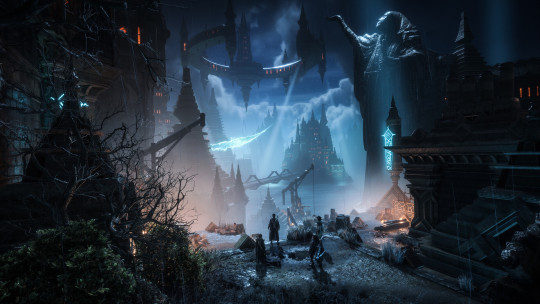
All of these elements make The Veilguard a fine fantasy action-adventure game – even a good one, I’d say. But as both the culmination of fifteen years of storytelling and as a narrative-based roleplaying game – the two most important facets of its identity – it consistently falls short. Dragon Age began as a series with outdated visuals and often obtuse gameplay, but was borne aloft by its worldbuilding, characterization, and dialogue. Now, that paradigm is completely inverted. The more you compare it to the older entries, the more alien it appears. After all these years of anticipation, how did it end up this way? Was this the only path forward?
Throughout The Veilguard’s final act, characters utter the phrase “Whatever it takes,” multiple times. Some might say too many. I feel like this mantra applied to the development cycle. As more struggles mounted, the team made compromise after compromise to allow the game to exist at all, to give the overarching story some conclusion in the face of pressure from corporate shareholders, AAA market expectations, and impatient fans. Whatever it takes to get this product out the door and into people’s homes.
This resulted in a game that was frankensteined together, assembled out of spare parts and broken dreams. It doesn’t live up to either the comedic heights or dramatic gravity of Inquisition’s “Trespasser” DLC from 2015, despite boasting the same lead writer in Trick Weekes. Amid the disappointment, we’re left with an unfortunate ultimatum: It’s either this or nothing.
I don’t mean that as a way to shield The Veilguard from criticism, or to dismiss legitimate complaints as ungrateful gripes. Rather, I’m weighing the value of a disappointing reality vs an idealized fantasy. The “nothing”, in this sense, was the dream I had for the past decade of what a perfect Dragon Age 4 looked like. With the game finally released, every longtime fan has lost their individualized, imaginary perfection in the face of an authentic, imperfect text. Was the destruction of those fantasies a worthy trade? It doesn’t help that the official artbook showcases a separate reality that could’ve been, with a significant portion dedicated to the original concepts for Joplin that are, personally, a lot closer to my ideal vision. I think it would’ve done wonders to ground the game as more Dragon Age-y had they stuck with bringing back legacy characters, such as Cole, Calpernia, Imshael, and the qunari-formerly-known as Sten.
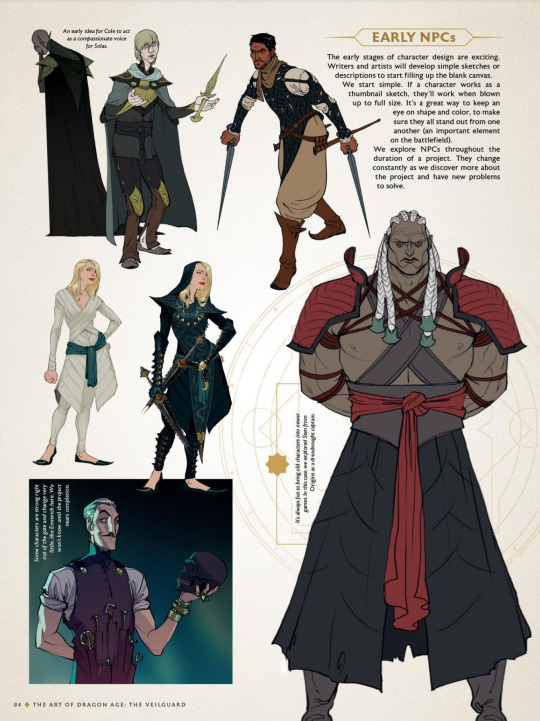
I don’t necessarily hate The Veilguard (I might actually prefer it to Dragon Age II), but I can’t help but notice a pattern in its many problems – a pattern that stems from a lack of faith in the audience and a smothering commitment to safety over boldness. As I examine its narrative and roleplaying nuances, I wish to avoid comparing it to groundbreaking RPGs such as Baldur’s Gate 3 (2023) or even Dragon Age: Origins (2009), as the series has long been diverging from that type of old-school CRPG. Rather, except when absolutely necessary, I will only qualitatively compare it to Inquisition, its closest relative.
And nowhere does it come up shorter to Inquisition than in the agency (or lack thereof) bestowed to the player to influence their character and World State.
II. Damnatio Memoriae
No, that’s not the name of an Antivan Crow (though I wouldn’t blame you for thinking so, since we have a character named “Lucanis Dellamorte”). It’s a Latin phrase meaning “condemnation of memory”, applied to a reviled person by destroying records of their existence and defacing objects of their legacy. In this case, it refers to the player. When it comes to their influence over the world and their in-game avatar, The Veilguard deigns to limit or outright eliminate it.
Save transfers that allow for the transmission of World States (the carrying over of choices from the previous games) have been a staple of the Dragon Age and Mass Effect franchises. Even when their consequences are slight, the psychological effect that this personalization has on players is profound, and one of many reasons why fans grow so attached to the characters and world. At its core, it’s an illusion, but one that’s of similar importance to the illusion that an arbitrary collection of 1s and 0s can create an entire digital world. Player co-authorship guarantees a level of emotional investment that eclipses pre-built backgrounds.
However, The Veilguard limits the scope to just three choices, a dramatic decrease from the former standard. All import options come from Inquisition, with two just from the “Trespasser” expansion. One variable potentially impacts the ending, while the other two, in most cases, add one or two lines of dialogue and a single codex entry. Inquisition, by contrast, imported a bevy of choices from both previous games. Some of them had major consequences to quests such as “Here Lies the Abyss” and “The Final Piece”, both of which incorporated data from two games prior. The Veilguard is decidedly less ambitious. Conspicuously absent options include: whether Morrigan has a child or not, the fate of Hawke, the status of the Hero of Fereldan, the current monarchs of Fereldan and Orlais, the current Divine of the southern Chantry, and the individual outcomes of more than two dozen beloved party members across the series. Consequently, the fourth installment awkwardly writes around these subjects – Varric avoids mentioning his best friend, Hawke, as does Isabela ignore her potential lover. Fereldan, Orlais, and the Chantry are headed by Nobody in Particular. Morrigan, a prominent figure in the latest game, makes no mention of her potential son or even her former traveling companions. And the absence of many previous heroes, even ones with personal stakes in the story, feels palpably unnatural. I suspect this flattening of World States into a uniform mold served, in addition to cutting costs, to create parity between multiple cooperative players during the initial live-service version of Morrison. Again, the compromises of the troubled production become apparent, except this time, they’re taking a bite out of the core narrative.
Moreover, the game’s unwillingness to acknowledge quantum character states means that it’s obliged to omit several important cast members. At this point, I would’ve rather had them establish an official canon for the series rather than leaving everything as nebulous and undefined as possible. That way at least the world would’ve felt more alive, and we could’ve gotten more action out of relevant figures like Cassandra, Alistair, Fenris, Merrill, Cole, and Iron Bull. Not to mention that The Veilguard’s half-measure of respectful non-intereference in past World States ultimately fails. Certain conversations unintentionally canonize specific events, including references to Thom Rainier and Sera, both of whom could go unrecruited in Inquisition, as well as Morrigan’s transformation into a dragon in the battle with Corypheus in that game’s finale. But whatever personal history the player had with them doesn’t matter. The entire Dragon Age setting now drifts in a sea of ambiguity, its history obfuscated. It feels as gray and purgatorial as Solas’s prison for the gods.
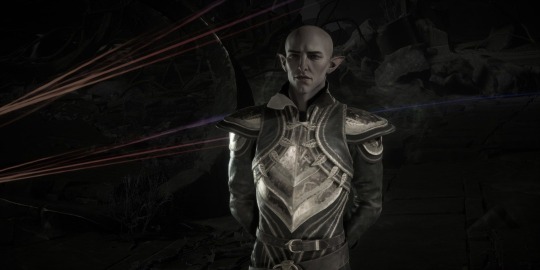
Beyond obscuring the past, The Veilguard restrains the player’s agency over the present. When publications first announced that the game would allow audiences to roleplay transgender identities and have that acknowledged by the party, I grew very excited – both at the encouraging representation, and at the depth of roleplaying mechanics that such an inclusion suggested. Unfortunately, The Veilguard offers little in roleplaying beyond this. The player character, Rook, always manifests as an altruistic, determined, friendly hero, no matter what the player chooses (if they’re offered choices at all). The selections of gender identity and romantic partner constitute the totality of how Rook defines themselves, post-character creation – exceptions that prove the rule of vacancy. Everything else is set in stone. The options presented are good, and should remain as standard, but in the absence of other substantive roleplaying experiences, their inclusion starts to feel frustratingly disingenuous and hollow, as if they were the only aspects the developers were willing to implement, and only out of obligation to meet the bare minimum for player agency. In my opinion, it sours the feature and exudes a miasma of cynicism.
Actual decisions that impact the plot are few and far between, but at least we have plenty of dialogue trees. In this type of game, dialogue options might usually lead to diverging paths that eventually converge to progress the plot. You might be choosing between three different flavors of saying “yes”, but as with the World States, that illusion of agency is imperative for the roleplaying experience. The Veilguard doesn’t even give you the three flavors – the encouraging, humorous, and stern dialogue options are frequently interchangeable, and rarely does it ever feel like the player is allowed to influence Rook’s reactions. Relationships with companions feel predetermined, as the approval system has no bearing on your interactions anymore. There are so few moments for you to ask your companions questions and dig in deep compared to Inquisition. Combined together, these issues make me question why we even have dialogue with our party at all. Rook adopts the same parental affect with each grown adult under their command, and it feels like every conversation ends the same way irrespective of the player’s input. With the exception of the flirting opportunities, they might as well be non-interactive cutscenes.
Rook’s weak characterization drags the game down significantly. With such limited authorship afforded to the player, it’s difficult to regard them as anything more than their eponymous chess piece – a straightfoward tool, locked on a grid, and moving flatly along the surface as directed.
III. Dull in Docktown
On paper, a plot summary of The Veilguard sounds somewhere between serviceable and phenomenal: Rook and Varric track down Solas to stop him from tearing down the Veil and destroying the world. In the process, they accidentally unleash Elgar’nan and Ghilan’nain, two of the wicked Evanuris who once ruled over the elven people millenia ago. With Solas advising them from an astral prison, Rook gathers a party together to defeat the risen gods, along with their servants and sycophants. Over the course of the adventure, they uncover dark truths about the origins of the elves, the mysterious Titans, and the malevolent Blight that’s served as an overarching antagonistic force. Eventually, Rook and friends join forces with Morrigan and the Inquisitor, rally armies to face off with their foes, and slay both the gods and their Archdemon thralls before they can conjure the full terror of the Blight. As Solas once again betrays the group, Rook and company have to put a decisive stop to his plans, which could potentially involve finally showing him the error of his ways.
The bones of The Veilguard’s story are sturdier than a calcium golem. Problems arise when you look at the actual writing, dialogue, and characterization – the flesh, blood, and organs of the work.

I���ve seen others chide the writing as overly quippy, but that better describes previous titles. Rather, I think The Veilguard’s dialogue is excessively utilitarian and preliminary, like a first draft awaiting refinement. Characters describe precisely what’s happening on screen as it’s happening, dryly exposit upon present circumstances, and repeat the same information ad nauseum. This infuriating repetition does little to reveal hidden components of their personalities, or their unique responses to situations. You won’t hear anything like Cole’s cerebral magnetic poetry or Vivienne’s dismissive arrogance. Many exchanges could’ve been uttered by Nobody in Particular, as it’s just dry recitation after recitation. It almost feels like watching an English second language instructional video, or a demonstration on workplace safety precautions. Clarity and coherence come at the cost of characterization and charisma.
Words alone fail to make them interesting. Most companions lack the subtlety and depth I had come to expect from the franchise, with many conversations amounting to them just plainly stating how they’re feeling. Most rap sessions sound like they’re happening in a therapist’s office with how gentle, open, and uncomplicated they feel. Compare this to Inquisition, where every character has a distinct voice (I should know, I had to try to copy them for that stupid application), as well as their own personal demons that it betrays: Sera’s internalized racism, hints of Blackwall’s stolen valor, Iron Bull’s espionage masked by bluster, or Solas’s lingering guilt and yearning for a bygone age. These aspects of their characters aren’t front and center, but things the audience can delve into that gives every moment with them more texture. The Veilguard’s companions lay out all their baggage carefullly and respectfully upfront, whether it’s Taash’s multiculturalism and gender identity issues or Neve’s brooding cynicism towards Tevinter’s underbelly. You’ve plumbed the depths of their personas within the first few minutes of meeting most of them.
Small exceptions exist. Professor Emmerich Volkarin stands out from the rest of the cast as a particularly inspired character: a charming, Vincent Price-like necromancer. His attachment to tombs and necromancy as a way to cope with his crippling fear of death makes for curiously compelling melodrama. The way in which he ultimately has to face his fear – either by foregoing his opportunity for immortality to save his beloved skeletal ward, Manfred, or by allowing his friend to pass on so that he can transcend into a new type existence – rises above the other binary choices in the game by being both narratively interesting and legitimately difficult to judge. Still, I feel Emmerich’s whole “lawful good gentleman necromancer” conceit, while a unique and clever subversion of tropes, would’ve worked better if it actually contrasted with anyone else in the party. Instead, the whole crew is full of unproblematic do-gooders who are forbidden by the game to nurture any meaningful interpersonal conflict. While I’d appreciate this lack of toxicity in my real-life relationships, fictional chemistry demands more reactive ingredients.

The Veilguard’s developers frequently positioned the game as “cozy” and about a “found family”, but I can guarantee you that there’s more tension at my Thanksgiving dinners than there is anywhere in this title. This family would get along swimmingly even during a presidential election. The thing about the “found family” trope is that it’s more satisfying when it’s earned. Here, it represents the default state, the starting point, and the status quo that they will always return to. Any minor squabbles (Harding wanting to sleep in the dirt, Emmerich taking too many books on a camping trip, Taash not liking necromancy) are introduced and squashed within the same scene. They all feel so extraneous. There’s so little friction among the companions here that you’d think it disproves Newton’s Third Law. The previous games never struggled in this regard, which makes the choices here all the more baffling.
Beyond the intra-party dynamics, characters lack grit or darkness to them – even when the narrative absolutely calls for it. Remember how I described the necromancer as lawful good (to use traditional Dungeons and Dragons alignments)? Yeah, that’s every character. Even the demonic assassin. Lucanis is a notorious hitman possessed by a demon of Spite, and possibly the weakest character of the game. This may or may not be due to the fact that his writer, Mary Kirby, was laid off mid-development. Regardless, he has noticeably less content than the other party members and generally feels unfinished. The demonic possession storyline goes nowhere; he doesn’t exorcise Spite, nor does he learn more about it or how to live with it. Instead, Spite is just an excuse to give Lucanis cool spectral wings (which he will use to fail several assassination attempts). The demon itself mostly just comes across as rude rather than threatening. The biggest issue, however, stems from the absence of any edge to Lucanis. When confronting his traitorous cousin, Ilario – the man who sold out Lucanis’s family to an enemy faction, kidnapped his grandmother, and made multiple attempts on his life – our grizzled, hardened assassin, pushed to the brink, demands… due process. Seriously, if your choices have led Lucanis to have a hardened heart, his method for dealing with the grievous traitor is sending him to jail. That’s The Veilguard’s idea of vindictive brutality among a clan of unforgiving murderers-for-hire. By contrast, Inquisition features Sera insubordinately murdering a stuck-up nobleman for talking too much. I believe that if modern BioWare had written The Godfather (1972), it would’ve ended with Michael Corleone recommending his brother-in-law to attend confession and seek a marriage counselor.
The writers seem intent on making the cast wholly unproblematic, with no way that the audience could ever question their morality or taste the delicious nuance of seeing someone you like do something bad. Measures were taken to child-proof every aspect of the good guys so that they couldn’t possibly be construed as anything else – even if it constricts them to the point of numbness and eventual atrophy.
To make things as palatable and accessible as possible, the language itself was dumbed down. Characters make frequent use of neologisms and bark phrases like “Suit up,” or “These guys go hard.” It emulates popular blockbuster superhero stuff rather than staying true to the diction the series traditionally employed. It’s all about the team, and the entire Dragon Age world has been stripped down into simplistic conflicts and recognizable stock characters.
This is why The Veilguard’s story largely fails. Despite being ostensibly being about the characters, they come off as an afterthought. Most of the time, only the sole requisite follower has anything to say on a given mission. Even in combat, their wholeness as fully-implemented party members falls short of expectations. Their damage output pales in comparison to the Rook’s, they have no health and cannot be downed in battle, and they mainly exist to give the player three extra ability slots. That’s the game’s true ethos for the companions, whether in combat or dialogue – utility, tools to make things happen rather than elegantly crafted identities. We end up with the largest amount of content per companion among any game in the franchise, only to have the weakest roster.
I know these writers can do better, because I’ve seen them do better. Trick Weekes wrote Iron Bull, Cole, and Solas in Inquisition, as well as Mordin Solus and Tali’Zorah in Mass Effect 2 (2010) and Mass Effect 3. Mary Kirby wrote Varric throughout the series, as well as Sten and Loghain in Origins. Plenty of other experienced writers, such as Sylvia Feketekuty and John Dombrow also contributed, so I can’t put any of the blame on a lack of skill. I don’t know if the mistake was trying to appeal to a wider audience, or if the constant reorientations of the DA4 project drained the crew’s passion and left them lacking in time to polish things.
I personally suspect that the writers had to rush out a script for all of the voiced dialogue. A video from August of 2020 showed off the voice actors for Davrin and Bellara, more than four years before the final game’s release. I think the codex entries, letters, and missives that you find throughout the game, which consist of only text, are much better written than the dialogue. My theory is that the writers had more time to revise and spruce up these tidbits, where edits were minimally invasive, as far as production is concerned. But my knowledge is limited; after all, BioWare rejected my application almost a decade ago.
Still, there are aspects of The Veilguard’s plot that I enjoy. The lore reveals were particularly satisfying2, and many felt rewarding after a decade of speculation. I called that elves were originally spirits, as well as the connection between the Archdemons and the Evanuris, but I wouldn’t have guessed that the Blight formed out of the smoldering rage of the Titans’ severed dreams. I’d concisely describe The Veilguard’s story as the opposite of Mass Effect 3: Whereas ME3 did excellent character work, the characterization in The Veilguard leaves much to be desired. Whereas ME3’s tone was overwhelmingly grim, The Veilguard feels inappropriately positive. Whereas ME3’s lore reveals ruined much about the series’s mystique, The Veilguard’s helped tie the setting’s history together. And whereas ME3 fumbled the ending about as much as it possibly could, The Veilguard actually coalesces into a spectacular third act.
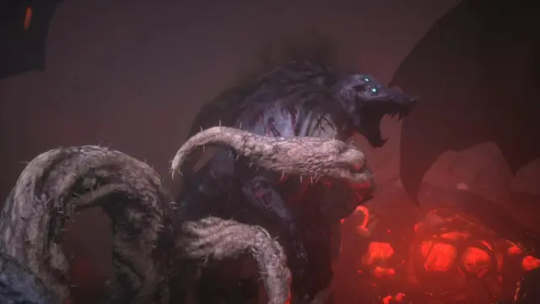
While I think the twist with Varric’s death is weak (outright pitiful compared to the Dread Wolf twist of Inquisition), the actual events that make up the finale carry a momentum and urgency that the rest of the game severely lacked. Everything from the sacrifice and kidnapping of Rook’s companions to the slaying of Ghilan’nain to the awe-inspiring battle between the Dread Wolf and Archdemon Lusacan – the whole affair takes the best parts of Mass Effect 2’s Suicide Mission and elevates it to the scale of an apocalyptic series finale. Ultimately, Solas takes center stage as the final antagonist, and the drama crescendos to a height the rest of the game desperately needed. He remains the most interesting character in the game and perhaps the franchise, and thankfully, the resolution to his story did not disappoint me (though I would’ve preferred the option for a boss battle against his Dread Wolf form if the player’s negotiations broke down). So in that sense, I think the worst possible scenario was avoided.
But is that really worth celebrating? Averting complete disaster? Exceeding the lowest standards? In many regards, The Veilguard still could have been – should have been – more.
IV. A World of Tranquil
In my essay on Final Fantasy VII: Rebirth (2024), I briefly discussed a trend in media to sand off the edges so as not to upset the audience in any way. The encroachment of this media sanitization seems to be an over-correction to the brimming grimness of late 2000s and early 2010s fiction (to which the first two Dragon Age titles belong), which earned comparable levels of criticism. Like Solas, I occasionally feel trapped in a cycle of regret, where it feels like our previous yearning for less aggressive, mean-spirited content led to a media landscape that prioritized patronizingly positive art. Now it’s clear to me that, in order to have a point, you need to have an edge.
Dragon Age historically drew a very progressive audience, and many of them congregated around Tumblr in that website’s heyday. Tumblr has garnered something of a reputation for overzealous discourse and sensitivity among its userbase, and I think that the developers of The Veilguard, in an attempt to cater to one of their core audiences, may have misunderstood both that passion and the fundamental appeal of their products. They became so concerned about optics, about avoiding politically charged criticism, that they kneecapped their world-building, rendering it as inoffensive and sterile as possible. It’s not so much “PC culture” as it is “PG culture.”
To that end, the various governments, factions, and societies of Thedas lost their edge. Dragon Age previously presented itself as anti-authoritarian by showcasing the rampant abuses of power across all cultures. Whether it was the incarceration of mages under the Chantry, the slavery practiced by the Tevinter Imperium, the expansionist anti-individualism of the Qun, the restrictive dwarven caste system, or the rampant racism against elves, social strife abounded in this world. I think that’s one thing that drew so many marginalized fans to the series. But the correlation of fictional atrocities with those of real life frequently prompted volatile discourse, with many concerned about how allegedly allegorized groups were being represented. You began to see countless essays pop up by folks who use the phrase “blood quantum” more than any healthy person should for a setting about wizards. BioWare responded to this by making Thedosian society wholly pleasant and the people in power responsible and cool and the disparate cultures tolerant and cooperative. If nothing’s portrayed negatively (outside of the cartoonishly evil gods), nobody can take offense, right?
For starters, the Antivan Crows have gone from an amoral group of assassins to basically Batman. These figures, which previously purchased children off slave markets to train them into killers, are now the “true rulers” of Antiva, by which the official government derives its authority. The Crows in The Veilguard stand against the insurgent qunari army as heroes of the common folk. They’re not an unscrupulous faction that Rook is reluctantly forced to ally with for the greater good; no, the Crows are simply good guys now. When the pompous governor of Treviso rails against them, with such audacious claims as “assassins and thugs should not represent the citizenry,” we’re meant to laugh at the governor’s foolishness. The unintentional implication this sends is that lethal vigilantism and unchecked power are cool because the people who use it are cool and stylish. The slave trade goes unacknoweldged; Antivan children want to grow up to be assassins now. The Crows never do anything wrong in The Veilguard – the governor is later revealed to be cooperating with the invaders for their own power. BioWare avoids the unpleasantness inherent in the Crows’ concept by pretending it never existed.
Perhaps more ridiculous is the Lords of Fortune, a new faction of pirates and treasure hunters based out of Rivain. Except they don’t really do piracy or treasure hunting. The game goes to lengths to ensure that the audience knows that the Lords don’t steal important cultural artifacts from any of the tombs and ruins they raid. What do they steal, then? There is no such thing as an ethical treasure hunter – plundering indigenous sites for souvenirs is inherently problematic – but the writers wanted to reap the appeal of adventurous swashbucklers without any of the baggage, regardless of whether it makes sense or not3. It comes across as a child’s idea of a pirate: they’re not thinking about the murder and looting, just the funny men with eye-patches who say “ARRR!” The developers want us to like the Lords of Fortune, and to that end, they can’t do anything culturally insensitive – even fictional disrespect toward a made-up culture. This is doubly amusing because the Lords are represented by Isabela from Dragon Age II. The same Isabela that kicked off a war with the qunari by stealing their holy book, the Tome of Koslun. This irony goes unacknowledged by the game.4
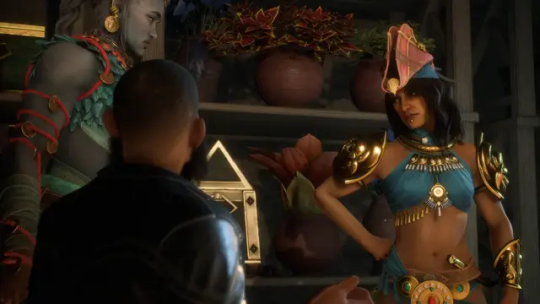
When these rogue buccaneers aren’t busy giving land acknowledgments to displaced Dalish elves or whatever, they’re enjoying their nonviolent coliseum. Pirates revel in bloodsport, but only so long as no actual blood is spilled. The Lords refuse to fight prisoners or animals in their arena, as they find such acts too cruel. I guess they’re all big Peter Singer readers. Instead, they summon spirits to adopt the visages of common enemies so that the player can kill them with a clean conscience. It’s another example of wanting to have your cake and eat it too – they wanted to create a glory hunter/gladiator faction, but couldn’t stand the underlying implications of such. So they twisted and bent them to fit into their unproblematic paradigm, leaving the Lords flavorless and lame. They barely even contribute to the main story, and they’re practically the only look we get into Rivaini society (which remains criminally underdeveloped).
More tragic is the handling of the qunari, once one of the most unique and nuanced civilizations in the Dragon Age setting. The Qun, as portrayed in the first three installments, is a society that demands all of its composite parts work in harmony. Thus, they have predetermined vocations for their children, rigid gender roles, strict codes of conduct, and an ambition to “enlighten” the rest of the world. While the Qun has often been presented as antagonistic toward the heroes, the series has commonly balanced its portrayal by showing how seductive its absolutism can be for people without hope. In some cases, life under the Qun is preferable, as is the case with former Tevinter slaves. Conformity becomes comfort when the world is regularly threatening to split apart.
The Veilguard opts for a different approach. See, Rook’s not fighting members of the Qun in this game – they’re fighting the Antaam, the former qunari military. The Veilguard constantly reiterates that the Antaam, which makes up one of the three branches of the Qun, has broken off and decided to invade, pillage, and stoke chaos. BioWare didn’t want the questionable morality and complexity of fighting an invading people from a humanized, multi-faceted culture, so they removed their culture. Their efforts to turn the non-Western-coded qunari into something digestible for their mistaken conception of a modern audience instead results in two caricatures: one being a fetishized, perfect society where there are no perceivable social ills; and the other a bunch of rampaging brutes.
Contending with a realized conception of Plato’s Republic mixed with the Ottoman Empire makes for more compelling drama than a horde of murderous giants. Again, BioWare wanted to have it both ways, and they still needed nameless, faceless orcs to kill. So every bit about the qunari’s militancy, imperialism, and repression coexisting alongside some of their more progressive ideas and communal unity is stripped of its context and meaning. Blame is placed solely on the Antaam, who no longer represent (and retroactively, never represented) the Qun’s ideology. It’s a cowardly compromise, attempting to pin the blame of all the Qun’s failings on a renegade military and seeking to exonerate the political and social apparatuses of their culpability.
At one point, a minor character named Seer Rowan lectures to an ignorant human (a proxy for the audience absorbing these retcons) that qunari society has always been egalitarian in practice, with mages enjoying freedom there. Previous games showed that the qunari shackle their “saarebas” mages, stitch their mouths, cut out their tongues, and teach them to commit suicide if they ever stray from their masters. However, we’re now assured that this is only practiced under the Antaam, and No True Qunari would ever do such a thing. Ignore the fact that, in Inquisition, we witness the enslaved saarebas under the supervision of the Ben-Hasserath, a subdivision of the Ariqun (i.e. not part of the Antaam). In fact, the Antaam that Rook fights in The Veilguard never command saarebas at all. They’re completely absent from the game (likely because the image of the bound, mutilated minority was too much for The Veilguard’s sensibilities). Seer Rowan’s weak, conciliatory retcon can’t even justify itself in its own game. The scolding diatribe communicates an intrinsic misunderstanding of the Qun by the writers – namely, it continues the pattern established with the Antivan Crows that the mechanics of power in society are fundamentally good as long as aberrant forces aren’t in charge. While I understand the desire to be conscientious about the portrayal of fictional cultures that draw upon non-Western traditions and iconography (which have historically been demonized in media), glamorizing the Qun and stripping it of its realistic nuance does little to alleviate any problems with representation. If anything, it creates new ones.
But hey, now we have our faceless orcs to guiltlessly slaughter. That’s what the Antaam’s been reduced to, bereft of the ideology that made them people. We kill them because they’re strange and scary and foreign and seeking to destroy our cities for fun. They remain the most prominent representation of the qunari in-game, barring our party member Taash. BioWare’s attempts to reverse what they viewed as problematic components to the qunari instead devolved into the very tropes they wished to avoid.
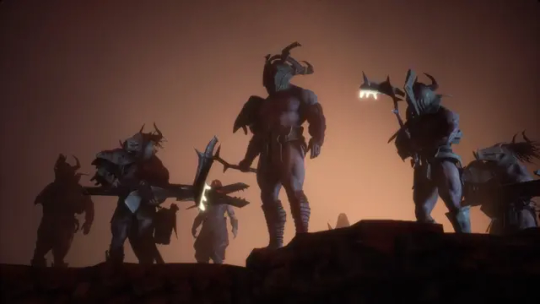
Which leads us to the elves. Much of the series’s discourse has surrounded the portrayal of the long-suffering elven people, who endure slavery under Tevinter, expulsion from their homeland in the Dales, confinement in ghettos, and the general disdain from other races. The games’ stories use symbolic shorthand of real-life oppressed peoples to communicate these tragedies, and this has led to a variety of intense, emotional interpretations over the years. The unending misery of the systematically marginalized elves hasn’t gone unnoticed by the fanbase – and their criticisms haven’t gone unnoticed by the developers. To quote The Veilguard’s creative director, John Epler, in an interview with Polygon:
“Dragon Age has not always been the kindest to the Dalish [elves]. Somebody once made a joke to me, and it’s not untrue, that it’s possible to wipe out a Dalish clan in all three of the games in some way.”
He and others on the development team must’ve thought elves needed a break, because the omnipresent racism against them vanishes completely in The Veilguard. Tevinter, an empire built on the back of chattel slavery, doesn’t show any of that. Consequently, it feels like players in the know still haven’t seen the true face of Tevinter, despite spending half a game there. The notion that the capital of Minrathous gives now is one of a prosperous city that’s centuries ahead of the countries down south, rather than a cruel regime cracking the whip at every opportunity. Perhaps the writers weren’t comfortable portraying this, or felt that their audience might not be amenable to it after years of incendiary argumentation. Nevertheless, it castrates their established world-building and robs us of the opportunity to witness true elven liberation in the climax. With both the fall of Minrathous and the toppling of the tyrannical elven gods, we could have delivered a much needed catharsis after four games of oppression, but The Veilguard forgoes this storytelling opportunity to play it safe.
I worry that this hesitancy originated from anxieties about the sensitivity of depicting marginalized peoples in brutal, dehumanizing conditions, and how that might look to more fragile viewers. But I think it’s important for all players, watchers, and readers to know that, though there might be aspects shared between them, fictional minorities are distinct from real ones.
Dragon Age’s elves are aesthetically Celtic. Their residency in alienages evokes images of Disapora Jews in Europe. Their Long Walk after being driven from the Dales calls back to the Trail of Tears, sharing an experience with Native Americans. Their subsequent migratory nature is reminiscent of the Romani people. And their ancient empire of Arlathan, with its large columns and temples of worship, headed by ascended humanoid (for lack of a better term) deities that cast down an enemy called the Titans, and which has since had its religion and culture co-opted and renamed by Roman-inspired Tevinter invites comparisons to classical Greece.
My point is, the elves of Dragon Age don’t represent one group of people, because fictional cultures are constructs drawing from countless inspirations. If they represent anything beyond themselves, it’s the idea of a proud people that’s fallen under the yoke of conquering powers – a supervictim to embody all. The idea that one must be limited in their storytelling options based on how the portrayal might reflect upon or disrespect an existing culture is flawed, in my opinion. In the overwhelming majority of cases, coding cannot be read as a 1:1 allegory, especially in speculative fiction like science-fiction and fantasy. I believe the most mature way to evaluate a story isn’t to try to pigeonhole what it’s trying to say say about who, as if there’s some insidious encrypted message in the text. Rather, it’s to see the forest through the trees and interpret the work as a complete whole in itself.
On that basis, I ask: would it have been so bad to see some of those enslaved elves, praying for salvation, side with their manipulative, nefarious gods? To add some nuance to the conflict with Elgar’nan and Ghilan’nain, would the story of elven liberation not have been better if the game actually engaged with it? Could we actually have a moral quandary with those whom Rook ends up fighting, even if the content might be seemingly problematic?
Epler might respond in the negative, per the Polygon interview, claiming that the gods “simply don’t care” about the elves.
“Those blighted, decrepit gods, they’re not bothering with the soft pitch. Their pitch is, We’re going to make a horrible world. We’re going to give you a lot of power, and maybe you’ll be OK.”
Like a chess board, the core conflict of The Veilguard is black and white. BioWare abandoned the chance to make Elgar’nan and Ghilan’nain more interesting villains because it was too risky.
Similarly risky was Solas’s role as an antagonist, since his motivations, as explained in “Trespasser”, are deeply sympathetic. Perhaps too much so for the developers’ comfort. Unlike the Evanuris and their disinterest in the elves, Solas wants to restore the elven people to their former glory. At least, that seemed to be his pitch in the last game. Frustratingly absent from The Veilguard are the Agents of Fen’Harel – elves who swore fealty to Solas’s cause. They infiltrated and compromised the Inquisition, effectively precipitating the final decision to end the organization in its current form. The idea that Solas had amassed an army of common folk who found the idea of a renewed elven empire appealing made him appear formidable and intimidating. “Trespasser” implies that a mass uprising of elves under Solas’s leadership was imminent, and anyone could be in on it.
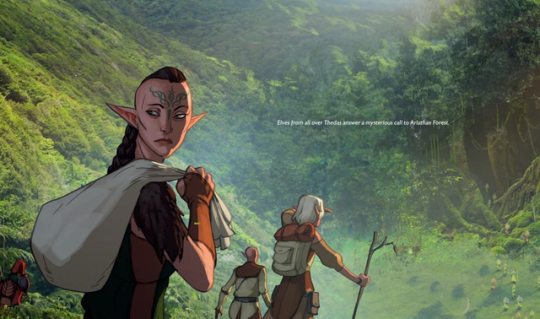
None of this happens in The Veilguard. Not only does Solas lack an army, but their absence isn’t explained or even acknowledged. As a result, Solas remains a passive antagonist until near the end, since the player has no disciples of his to contend with (either physically or ideologically) along the way. It wastes a side of his character that had been foreshadowed in a decade-long cliffhanger – that of a charismatic leader, capable of coordinating a rebellion that could spell disaster for its own followers.
In a Reddit AMA after the latest game’s release, Epler answered where the Agents of Fen’Harel disappeared to:
“Solas’ experience leading the rebellion against the Evanuris turned him against the idea of being a leader. You see it in the memories – the entire experience of being in charge ate at him and, ultimately, convinced him he needed to do this on his own. And his own motivations were very different from the motivations of those who wanted to follow him – he had no real regard for their lives or their goals. So at some point between Trespasser and DATV, he severed that connection with his ‘followers’ and went back to being a lone wolf. There are Dalish clans who are sympathetic to his goals, but even there, there’s an understanding that he’s too dangerous to have a more formal connection with, and that he will, ultimately, sacrifice them to his own ends if necessary.”
I find this explanation unsatisfying, not the least bit because the narrative offers next to nothing to imply this. The disappearance of Solas’s agents represents my biggest bugbear with the game, depriving it of the full potential of its highly anticipated antagonist in favor of the more generically villainous Evanuris. Moreover, this omission fits into the aggravating blueprint for The Veilguard’s inoffensive direction. The motivations, emotions, and backgrounds of the Agents of Fen’Harel would be sympathetic, and therefore might problematize the otherwise cut-and-dry conflicts. Epler seemed concerned that audiences might think Solas was “a little too sympathetic in his goals,” according to an interview with GamesRadar+.
But that’s the thing: sympathy isn’t endorsement, and portrayal of sympathetic characters isn’t endorsement either. But neither does that invalidate the emotions and experiences that generate that sympathy, even if the character’s actions ultimately turn toward evil. I’ve noticed a trend (especially in symptomatic criticism, which I generally dislike5) to view art as propaganda, and to evaluate it from a moralizing, top-down perspective. Antagonists with complex or understandable motivations (in this case, revolutionary villains) are often judged by this framework as tools for stories wishing to champion the status quo. Common arguments that I’ve seen imply that the relatability that we often find in villains is not a strength of the writing, but a devilish trick of ideology by which writers can reinforce conservative doctrine, to scold us away from certain beliefs. Any decent writer knows this isn’t the case, and that people don’t write morally or emotionally complex antagonists for didactic purposes. Instead, characters such as these embody the anxieties of their creators – the fear of losing yourself to your passions, the fear of going about things the wrong way, the fear of sacrificing too much to achieve your desired ends. The concepts and feelings that compel these characters remain authentic to the writer’s heart and the connection they established with the audience.
Art isn’t propaganda. To read it as such reduces it and promotes intellectual dishonesty and foolhardy myopia. Stories are irreducible (otherwise, we would not waste our time with them), and so I believe interpretations should be formed from the bottom-up, rooted in the text as much as possible. The “message” cannot be imposed from the top-down, but symptomatic readings, in their focus on tropes and cultural context, frequently condemn without a trial. Hindering your story in order to future-proof it for the sake of optics is a safeguard against this, and one that leads to bad stories. Artists should have confidence that their text will hold its ground on its own. To quote Ursula K. Le Guin’s essay “A Message about Messages”:
“The complex meanings of a serious story or novel can be understood only by participation in the language of the story itself. To translate them into a message or reduce them to a sermon distorts, betrays, and destroys them… Any reduction of that language into intellectual messages is radically, destructively incomplete.” (67-68)
BioWare’s doctrine of passive writing violates this wisdom by surrendering to their fear of (bad) criticism. The Veilguard lacks punch, stakes, and empathy and becomes incongruous with its established lore because it’s not willing to take risks that might alienate or upset players. They’re more concerned with making sure their work is inoffensive than they are with conveying a moving story.
I believe all of this was inherited from an incestuous feedback loop between a vocal minority of critics, of which I might’ve once counted myself among the blameworthy, and the apprehensiveness of out-of-touch corporate board room decision-making. Dragon Age’s genome mutated, and it slowly lost its teeth.
Over the course of a decade, we bred the Dread Wolf into a Dread Pug.
V. What It Took
The Veilguard’s lack of confidence in itself and lack of faith in its audience contribute to its capitulatory nature. In many respects, it feels like the developers lost their passion for it over the course of the ten year hellish production and just wanted to be done with it. This resulted in a decent game that nonetheless feels divorced from what came before it. It tries to juggle being a soft reboot while also trying to close out the series’s biggest and longest running story arcs, but inevitably fumbles.
Nearly everything done by The Veilguard was handled better by Inquisition. And Inquisition was certainly the more ambitious title. Perhaps more returning characters would have established a sense of continuity between the two, or at least made it less awkward by having them present for the story’s grand finale. For as strong as the endgame is, it could’ve benefited from the presence of slave liberator Fenris, elven history aficionado Merrill, possible Evanuris soul vessel Sera, or Divine Victoria (any of them). The core pillar of Dragon Age is the characters, and The Veilguard’s under-performance (and in some cases, outright dismissal) in that regard sabotages its integrity. Without this to anchor it, the changes to gameplay, visuals, and roleplaying depth become more alienating.
Personally, what do I take away from this? The Veilguard is far from the game I dreamed about for ten years, and not the one that loyal fans deserved either. I’m no stranger to disappointment at this point in my life, and yet this still leaves me with a hollow feeling. Will I still be able to return to Inquisition, a game I truly adore, and see it the same way as before, knowing now where all this is leading? The true cost of The Veilguard, for me, has nothing to do with the price tag: it’s the loss of that perfectly tailored dream, now that the possibilities of the future have shut their gates.
Where do those dreams go? Are they doomed to fester in their lonely, incommunicable agony? Will they be twisted by their enmity, like the blighted dreams of the Titans, and spread their corruption into those important happy memories?
In 2014, I was depressed as fuck, and Dragon Age: Inquisition helped me to see the light and come out of it. In 2024, I was depressed as fuck, and Dragon Age: The Veilguard made me feel nothing. There’s no less favorable comparison in my eyes. It’s disheartening to behold something that once meant so much to me and be greeted with numbness. I have to wonder if that affection will ever return, or if I’ve just grown out of it.
But as I wandered the streets of Minrathous as Rook, I heard a familiar song. It was one of the tavern songs from Inquisition, its nostalgic chords filling me with wistful sentiment. I know, deep down, there’s still something there. Maybe I just need to dig it up. Maybe it’s time to look back…
To be continued…
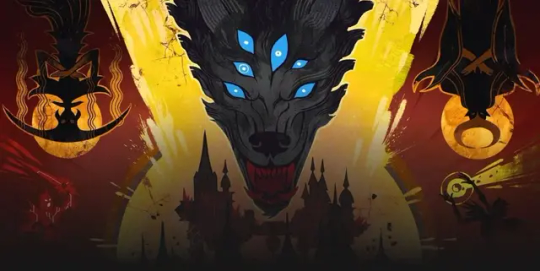
– Hunter Galbraith
Further Reading
Le Guin, Ursula K. “A Message about Messages.” Wonderbook: The Illustrated Guide to Creating Imaginative Fiction, Abrams Image, 2018, pp. 67–68.
Incidentally, this was an anomaly my friends and I pondered over and eventually solved. It turned out to be a former Wienerschnitzel. ↩︎
You could argue that this credit goes more to Inquisition and the previous games for laying the groundwork for said reveals, which were obviously planned out ahead of time, as confirmed by the aforementioned official artbook. Regardless, the payoff satisfied me and gave me proper closure. ↩︎
I’ve been informed that there is a hidden conversation that explains that the Lords of Fortune do, in fact, sell cultural artifacts at times, but only to the rightful owners. This just makes me wonder what they do with the artifacts if the prospective clients can’t pay. Do they shove them back in the ruins and re-arm all the booby traps? ↩︎
I would argue that this does not represent character progression on Isabela’s part, as her (possible, depending on the player’s choices) return of the Tome of Koslun in Dragon Age II was a pragmatic sacrifice she made to save her friends and the city, rather than an acknowledgment of the qunari’s inviolable ownership. In fact, in many continuities, she never returns the Tome at all. ↩︎
I prefer more formalist criticism because it allows the text to lead the dance, not the critique. I think it’s only fair, given that the creators likely spent more effort crafting the piece than I spent consuming it. Symptomatic criticism mandates that the reader consider everything around the text, typically at the text’s expense. In the worst cases, symptomatic critics make their arguments about seemingly everything besides the text in question. ↩︎ Link to article: https://planckstorytime.wordpress.com/2025/01/01/dragon-age-the-veilguard-strangled-by-gentle-hands/
#planckstorytime#writing#analysis#essay#dragon age#datv spoilers#datv rook#dragon age veilguard#veilguard#dragon age inquisition#solas#lace harding#bellara lutare#davrin#elgar'nan#ghilan'nain#neve gallus#taash#lucanis dellamorte#emmerich volkarin#video games#rpg#bioware#dragon age 4#dragon age dreadwolf#da4#tevinter imperium#dorian pavus#inquisitor lavellan#solavellan
291 notes
·
View notes
Text
Goob Headcanons!
It's the Goob! The Goobert Snoobert!!!!
Romantic/Platonic Headcanons featuring some angst! :D
--------------------------
Goob loves hugs, and this is very obvious when he hugs you a little bit more often than he does with other toons. It's almost always on sight with him; the second he sees you his arms go flying out in your general direction. He doesn't always hit his target and may accidentally grab another toon or visitor of Gardenview.
Of course, when other toons comment on his behavior towards you, his response is almost always, "Oh yeah, I guess I have!" And doesn't really comment any further on that. In his mind, you always need a hug, no matter the time or place!
Except for funerals.
Assuming Gardenview already closed down and your doing your whole 'Ichor machine' mission; Goob is always close by. Sometimes coincidentally, but also because he doesn't like the idea of a Twisted chasing you and not being able to be there to help by hugging you out of the way. Even if you have the situation handled by getting out of sight, and sometimes putting himself in danger in the process. Please tell him that putting himself in danger just for you isn't always the best idea.
Visitors and Employees do comment on how you two are almost inseparable -Barring Scraps- because you're always around Goob or Goob and Scraps. Visitors find it cute while Employees find it confusing, considering that in my personal headcanon, you don't really meet each other in the show.
Unless you want to meet each other in the show, then the Employees won't comment on it.
Scraps adores your relationship towards Goob, romantic or not. The interactions you two have with each other are almost always fun to watch, barring Twisted chases. Sometimes she intentionally leaves you alone, saying she has to do something and then just watch you two do whatever, gushing over her brother getting along with you so well.
...
Of course, everything isn't always so dandy.
For sakes of actually having headcanons here, Twisted Goob isn't immediately hostile to you, just more watching you, unable to determine if he should attack or not. If you run away he'll just opt for walking after you. Not exactly chasing, just walking after you.
And he won't observe from a distance either, he'll be right there next to you while you extract a machine, sitting there silently while you're blissfully unaware of his presence. Once you're finished and see him, maybe you'll freak out, maybe you won't. Maybe your first instinct is to run, maybe it isn't.
Either way, you have a follower for the entire floor, whether you like it or not. It's mostly down to him just feeling really safe around you. You'll notice that his expression when Twisted is one of either pain or sadness (maybe some anger) but whenever he's around you, he feels a lot more safer and calm, with instead of the sad expression, it's more neutral or in rare cases happy. Of course, the smile would be the same as Twisted Scraps or Toodles, but it's still a smile!
That's not to say that he won't attack other Toons; he will but usually he can be calmed down by just putting yourself in front of the Toon in question. It'll temporarily calm him down enough to where the Toon can escape, (Assuming it's not a shrimp that'll stay due to him saying "I HATE TWISTED HUGGERS!!!!") and everyone is happy.
Eventually when panic time kicks off and see's everyone else going towards the elevator, he'll notice you're heading there too and kind of panic, kind of not. He'll assume it's just normal and that you'll be back eventually. So he'll wait.
And wait.
And wait.
Maybe you can see where this is going.
Much like Glisten, he'll have a breaking point if you encounter him too many times to the point where he'll just hug you and won't let go the next time you see him. A Toon will have to break you out of the not so restrictive prison by blowing a airhorn right next to him.
My personal headcanon around it is that Twisted Goob really hates being alone, just like Glisten. Except unlike Glisten, he won't... y'know, kill you. So with Goob, there's a lot less risk of dying with him, assuming there isn't another Twisted around. His arms are good for hugging tightly but not really good for defending.
Speaking of defending, for Twisted Goob, he'll grab the Twisted that's chasing you and just... Hug them. Allowing you time to escape and really pissing off the Twisted that he robbed of a hit or free kill.
...
But back to when things were happy and dandy!
A lot of visitors love to just see you two interact and basically do fluffy things, cuddling, hugging, interacting and playing, it's all well and good for corporate! They're earning money, the visitors are earning adorable photos and you and Goob are happily interacting with each other!
You'll notice in the interactions post I've made that his Hug ability he's usually protective or really likes hugs. Of course, he'll do this randomly and this can get really awkward if you were in the middle of an extraction, causing a failed skill check promptly having Twisteds coming after both of you. He'll just awkwardly chuckle and apologize, to which you might forgive him.
But in conclusion: For the fluffy parts of these headcanons, it's mostly you and Goob hugging and just having fun together. With the Angst parts of these headcanons, it's more or less Goob being a mix of protective and curious but also just self interested with him staying around you only so he can feel safe.
But to clarify, the Twisted version of him does like to be around you more because he likes you more than doing it out of self interest.
#Kind of had a ton of inspiration surrounding him#But can you blame me?#He's THE Goobert Snoobert!#Goob x Reader#Dandys world Goob x Reader#Dandy's World Goob x reader#Dandys world x reader#Dandy's world x Reader#Can be seen as platonic or romantic idc
167 notes
·
View notes
Text
Scrap Processing Machine by Intelliedge
Intelliedge offers a comprehensive range of scrap processing machines designed to efficiently handle and recycle various types of scrap materials, including metals, plastics, and paper. These machines are engineered with advanced technology and robust construction to ensure optimal performance and durability.
Key features and benefits:
High efficiency: Intelliedge machines are capable of processing large volumes of scrap materials at high speeds, maximizing productivity.
Versatility: The machines can handle a wide variety of scrap types, making them suitable for diverse recycling applications.
Durability: Built to withstand heavy-duty use, Intelliedge machines are designed for long-lasting performance.
Environmental friendliness: By promoting recycling and reducing waste, these machines contribute to a more sustainable future.
Customization options: Intelliedge can tailor machines to meet specific customer requirements, ensuring optimal fit for individual applications.
Popular scrap processing machines from Intelliedge include:
Metal shredders: Reduce large metal items to smaller, more manageable pieces.
Baling presses: Compress scrap materials into dense bales for efficient transportation and storage.
Sorting machines: Automatically separate different types of scrap materials based on their physical properties.
Granulators: Break down plastics and other materials into smaller granules for further processing.
Intelliedge's scrap processing machines are ideal for recycling facilities, scrap metal yards, and industries that generate significant amounts of waste. By investing in these machines, businesses can improve their environmental footprint, reduce costs, and generate revenue from recycled materials.
https://intelliedge.in/about-us
0 notes
Text
[You Give Them a Hug — Bad Batch (+ Omega!) Edition]
(aka: You broke them. And now they’re in love with you forever.)
So you peeps seemed to love the Clones Edition over here, so here is the Bad Batch version of it!!!
⚠️ TW: Not Canon. Just Vibes. ⚠️
This post contains: – Excessive hugging. – Deeply non-canon affection. – Clones feeling emotions they were not properly equipped to process. – A concerning lack of military professionalism. – Irreversible softness.
If you're looking for canon compliance, emotional restraint, or literally any kind of plot... you're in the wrong galaxy, sweetheart.
This is just me projecting unhinged love onto traumatized war orphans with muscles.
Proceed at your own risk. Hug responsibly. 💥🤗💥
Hunter
You hug Hunter and he just… stops functioning.
Like you initiated it mid-mission and this man has full-on emotion-induced lag.
“...Why’d you do that?”
“Because I wanted to.”
Loading Hunter.exe
He gives you this soft, stunned look like he didn’t know he needed physical affection until just now.
His return hug is slow, careful, warm. His arms wrap around your back and he doesn’t squeeze—he holds.
Stays silent for a moment. Then a low murmur: “...thanks. I needed that.”
From that point on, it’s Hunter Hug Radar Mode™.
You’re sad? He’s already moving.
You’re happy? Hug.
You yawned vaguely near him? “You look tired. C’mere.”
Somehow always smells like leather, dirt, and safety. It's like hugging your childhood treehouse and a protective panther.
Wrecker
OH.
OH YOU’RE IN FOR IT NOW.
You hug Wrecker and he goes FULL GOLDEN RETRIEVER MELTDOWN.
“AWwwwWWWWWWW!!! C’mere!!!”
Picks you up. Swings you. Spins you around until you’re dizzy and giggling and possibly concussed.
His hugs are LIFE-THREATENINGLY STRONG. Like being hit with a loving freight train.
“You’re the best! I’m gonna hug you every day forever now!!”
Immediately makes you a “You Hugged Wrecker” award out of scrap metal. It has glitter glue.
He initiates hugs constantly now. If you don’t hug him back fast enough, he starts whining like a sad bantha.
Tells Crosshair about the hug with tears in his eyes. Crosshair pretends not to care.
“They hugged me, man. Me!! WRECKER!!”
“Yeah, yeah. Don’t start crying again.”
Tech
You hug Tech and it’s like hugging a 3D-printed anxiety machine.
Freezes.
“Wh—what are you doing? Is this…physical bonding? Are you malfunctioning? Am I??”
Absolutely stiff as a board. One arm hovers near your back like he's trying to remember what humans do.
You explain it’s just a hug. Tech mutters: “Hmmm. Fascinating. Increases oxytocin. Improves cardiovascular health. Reduces cortisol. Hm.”
But then you do it again.
And he goes quiet.
Softer.
Then his hands gently rest on your back and he melts like butter under a Tatooine sun.
You pull away and he clears his throat 14 times and then gives you a 12-slide presentation on “the measurable benefits of repeat physical affection among squadmates (with graphs).”
Secretly loves it. Won’t say it, but builds you a hug simulator in case he’s unavailable.
Crosshair
Oh.
OH YOU BRAVE, BRAVE FOOL.
You hug Crosshair and it’s like hugging a sniper rifle possessed by the ghost of unresolved trauma.
“...What the kriff are you doing?”
Arms at his sides. Staring down at you like you're a wild animal. Clearly thinking “kill or cuddle?”
You say “just hugging you.” And he just…blinks. Once. Twice.
Then you feel it: the tiniest shift. He leans in. One hand—just one—lands gently at your waist.
It’s not a full hug. It’s not even half a hug.
It’s 0.5 seconds of fragile vulnerability.
Then he pulls back and growls “Don’t make a big deal out of it.” …But his ears are pink. And he doesn’t move away from you for the rest of the day.
Later that week, you find a ration bar left on your bunk. It’s the good flavor.
Written in Sharpie on the wrapper: "Since you like touching people. Here's something to touch your mouth." (he tried)
Echo
Echo is a man held together by trauma, stubbornness, and like...two screws and a charging port.
You hug Echo and it’s like hugging a haunted vending machine with trust issues.
He doesn’t react at first. Just stiffens. Hard. Like his brain didn’t even register this as an available interaction option.
“...Why?” he asks, very quietly. Not suspicious. Not annoyed. Just… genuinely confused. Like he doesn’t think people do that to him anymore.
You say, “Because you deserve it.” And he. Short circuits.
It’s all in the eyes. That distant, shell-shocked clone stare goes soft. And sad. You get half a breath of “I don’t—” before his voice goes hoarse and he just leans in.
One arm—cold metal, whirring servos—wraps around you. The other presses tight, his hand fisting in the back of your shirt like he’s scared you’ll vanish.
His forehead rests on your shoulder. You feel him exhale. And it’s the sound of a man finally letting go of a weight he’s carried since the Citadel.
When he pulls back, his face is unreadable. But he says “...Thanks,” with such quiet, aching sincerity it wrecks you for 48 hours.
The next time you get hurt, Echo’s at your side before the medic droid.
He doesn’t hug you again right away. But he touches your shoulder now. Bumps your arm. Stays close.
Then one day—randomly, silently—he hugs you first. No words. Just that same warm, quiet grip. Like saying: I’m still here. And so are you.
Omega
YOU HUG OMEGA??
SHE SHRIEKS WITH GLEE AND TACKLES YOU LIKE A TINY STAR-WARS THEMED KOALA.
“HUG TIME!!!”
Wraps every limb around you like she’s a baby monkey and you’re a tree.
Refuses to let go for 10 minutes. It’s warm. It’s pure. It’s the most healing hug in galactic history.
Immediately declares you her “hug buddy.”
Makes you a friendship bracelet with “❤️ HUGS THUGS 4 LIFE ❤️” on it.
Tries to get the rest of the squad to join in. “Group hug! Come on! HUNTAH YOU’RE NOT TA COOL FOR LOVE.”
Eventually becomes hug ambassador. Sneak attacks everyone until the whole squad is touch-positive.
Hunter now does “the forehead touch.” Wrecker hugs everyone at breakfast. Tech nods politely and lets her sit in his lap. Crosshair lets her hug him while muttering “don’t tell anyone.”
🧸 BONUS: Bad Batch Group Hug™
You say “GROUP HUG” and Wrecker YEETS HIMSELF AT YOU FIRST.
Omega screams “YESSSS!!” and jumps on like a koala.
Tech mutters “Oh no it’s happening again” and gets absorbed into the chaos.
Crosshair stands two meters away looking like a feral cat. But you hold out your hand and he sighs, grumbles, and slinks in like he’s being drafted into a cult.
It’s warm. It’s slightly sweaty. Someone’s armor is digging into your hip. But everyone’s breathing slows down. There’s peace.
You say “I love you guys” and Hunter goes silent. Then softly replies: “Yeah. You too.”
#star wars#sw tcw#clone wars#swtcw#clone troopers#star wars clone wars#star wars clones#star wars fic#star wars headcanon#the bad batch#clone force 99#sw tbb#bad batch#tbb#star wars tbb#tbb hunter#tbb echo#tbb crosshair#tbb omega#tbb tech#tbb wrecker
115 notes
·
View notes
Note
Hi! I just saw your quilted butterflies photo, and I was wondering if you would willing to share how to make them, or link to a tutorial? They're gorgeous and I'd love to try, but i don't know the right search terms to find those, i think.
Oh absolutely! Everyone needs an easy craft to do right now. This will be a photo tutorial, so if you need a video the search terms are "origami butterfly bookmark". The instructions will be pretty similar.
*If you are using a sewing machine a single butterfly should take between 15-30mins, and if hand stitching my guess is ~1hr
Tools: -2 Scrap fabrics or 2x fat quarters, one for the main/outer fabric, one for the inner contrast -I recommend quilting cotton, though any easily ironable, non-stretch fabric will work -ruler and marking tools -scissors OR rotary cutter and mat -Pins (if desired) -Thread in a matching OR contrast colour - depending on preference -Iron and Ironing board - You can use a piece of cotton folded into a thin pad in a pinch as long as it's flat!
Step 1: Cut out two rectangles. You can make the butterflies as big or small as you'd like, as long as it's in keeping with the 2:3 ratio. For me, I like to use 4" x 6" rectangles. Use your marking tools to mark out the rectangle on the back/wrong side of the fabric, then cut them out!

Step 2: Put the rectangles on top of each other, with right/patterned sides facing each other. Make sure all your corners and edges line up. Pin in place if using pins. (in this example one of my fabrics has the pattern on both sides of the fabric)
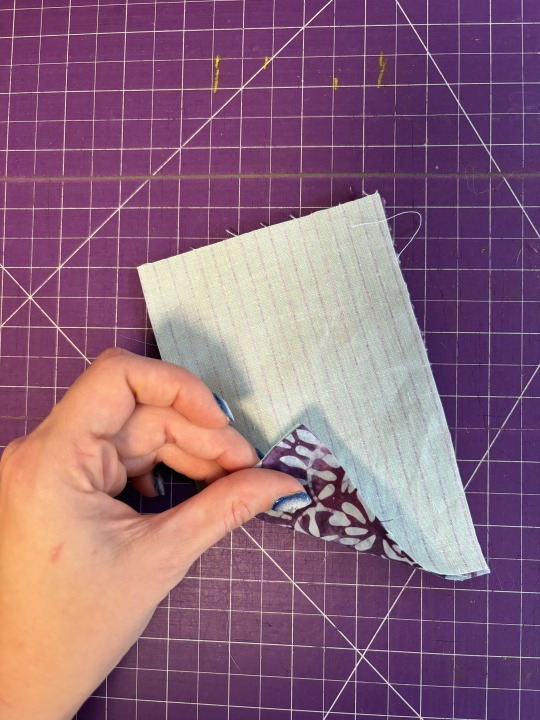
Step 3: Sewing! Mark a 2" gap on one of the short edges. If using hand needle mark out 1/4" distance from the edges. Sew. If using a machine, line up the edge with the 1/4" inch mark and sew. (Image is completed stitching, not placement on machine)

Step 4: Trim the corners without cutting into the stitching line, then flip the fabric inside out through the 2" gap you left. Make sure to stick your finger or something blunt but pokey -like a chopstick- into the corners to make sure they are nice and crisp!

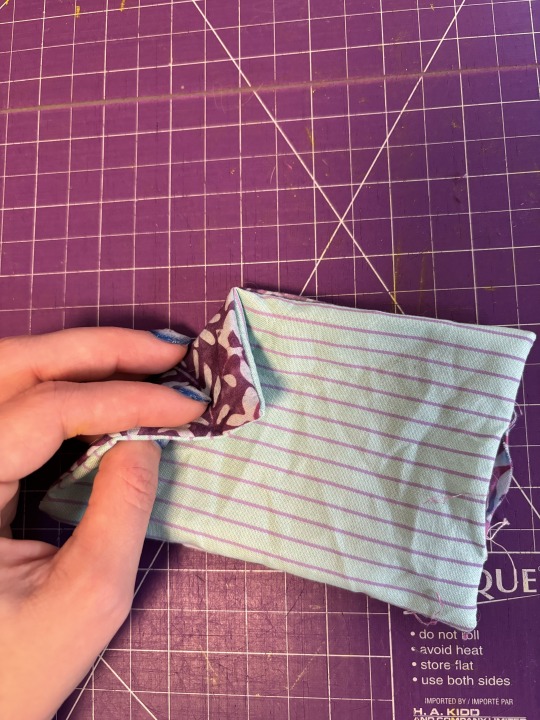
Step 5: Press all your frustrations out by pressing that fabric! Get it nice and flat and crisp! Make sure you've folded in the edges of the 2" gap to match the seam allowance of the already-sewn edges before you press. Then, if hand sewing, slipstitch the gap closed. If using a machine, set your fabric at a 1/8" distance and sew around the edges, effectively closing the gap and giving you a lovely topstitch detail.

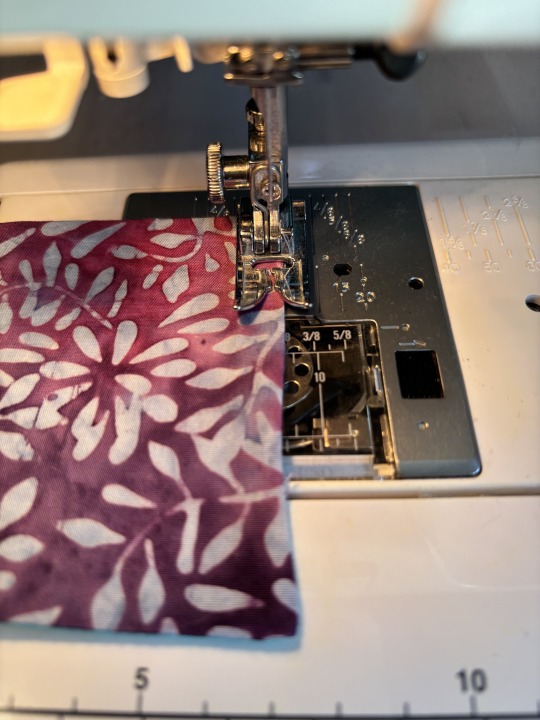

Step 6: Let's start folding! First move we're going to make is folding it in half, bringing the short edges together. Keep in mind, whichever fabric is on the outside will be the main fabric of your butterfly, and what is on the inside will be the contrast! Press hard! Then, make sure the edges you just brought together are facing you for the next step.


Step 7: Take the top fabric of the right open edge and bring it to the left side of the open edge. It will tent up in the corner, use this and press that tent down until you have what looks like a triangle of the outside fabric on top of two rectangles of the contrast fabric. Press! (I forgot to take pics of the whole process with the first one, don't mind the fabric switch).


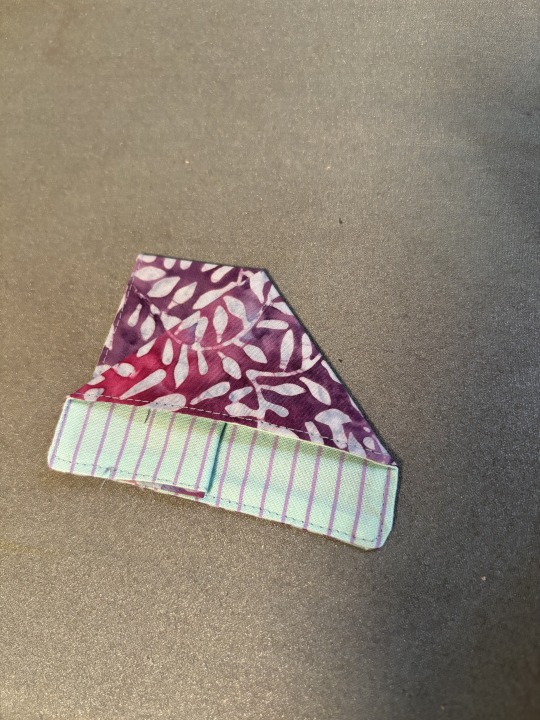
Step 7.5: Flip your butterfly and repeat step 7 on the other side until you have a strange looking triangle like this.
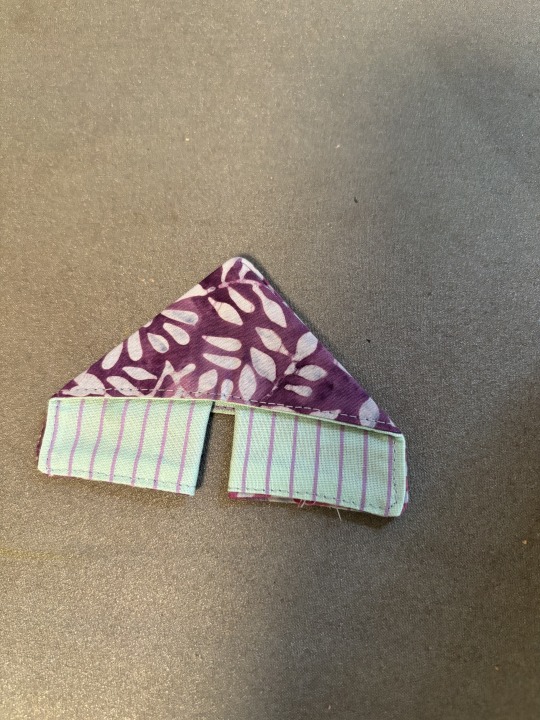
Step 8: Take the inner corners of the contrast fabric and fold it up towards the outer fabric. The bigger this fold, the more contrast fabric you will see in the final butterfly. Press.


Step 9: Take the tip of one of the corners you just pressed up and bring it back to it's original position. Do not press. Gently press down on the tip of the corner, letting the fabric unfold. The butterfly wing should unfold, with the contrast fabric showing in the centre. Adjust until you have as much contrast showing as you'd like, then press hard. Repeat on the other side.

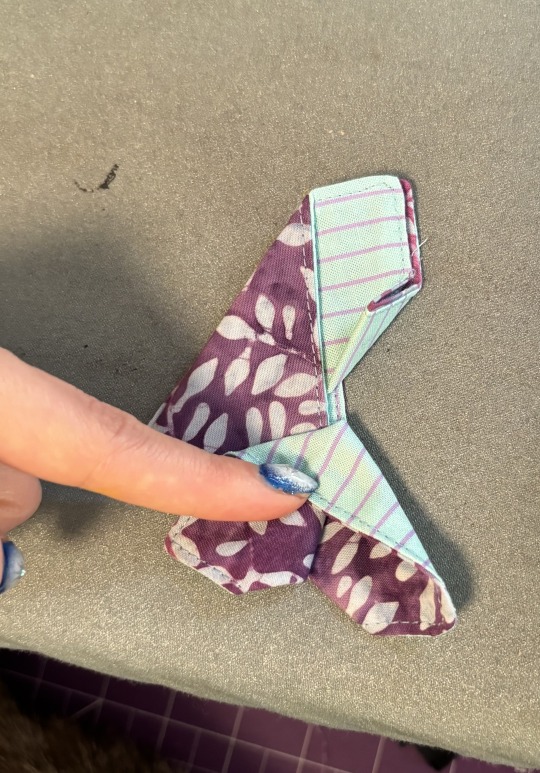
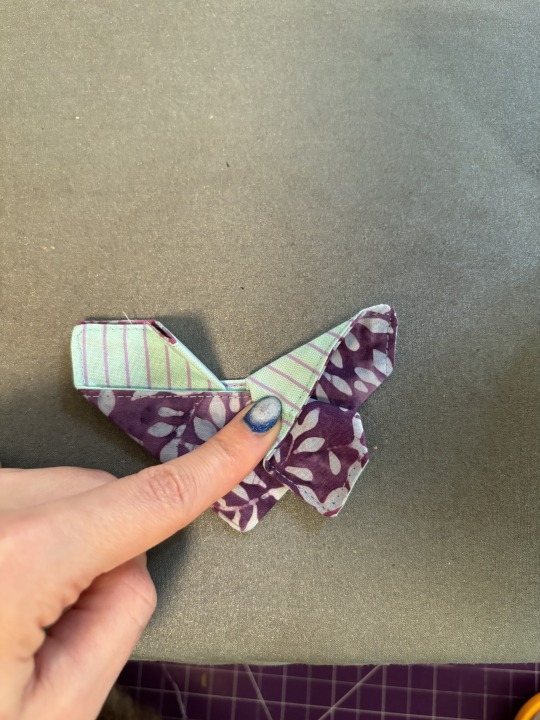
Congratulations!! You now have a butterfly!! You can make a garland, stick them on hairclips, or simply put them on your windowsill to keep you company! If you want to ensure that your butterfly doesn't unfold, you can add a small hand stitch in the centre of the two triangles that make up the "body" of the butterfly right along where the topstitching is.

Hopefully this was clear to follow, but if you have any questions, let me know!
224 notes
·
View notes
Note
Being that I’m sick, I just had a thought. In no shape or form do I think this is any bit accurate lol, but it was a fun thought for me.
So transformers are seen as robots (because they are), but I think it’s more important to look at the alien aspect of them. They are huge mechanical beings. Living machines. Being that they are living machines they don’t exactly get sick like most biological creatures such as humans.
Cybertronian’s suffer more from wounds and other injuries than they do sickness. A Cybertronian getting sick is nearly always a death sentence. This is completely different when it comes to humans. Unlike the giant robots, we get sick often, our bodies constantly healing itself. Cybertronian’s are more equipped to handle fatal wounds than we are. What a small scrap is to them can be deadly to humans.
That being said, transformers kind of are shocked when we can survive a mild fever. Our technology to heal the sick is much more advanced than theirs. Watching a small human get something like a mild flu is really fascinating to them. In a strange way they like seeing the whole healing process of humans getting sick and then better. Our bodies are so much frailer than theirs, yet we can fight of an infection that could potentially wipe out large numbers for them.
When you are sick, expect a lot of touching for no reason. Your body is weak from whatever sickness you have, yet they can’t stop poking and feeling. Your movements are slower and you’re less aware now, in a way it’s cute to them. Strangely enough they’d probably also like the smell of sickness on a human…strange but they’d most likely find it fascinating.
There are some bots I can also see getting turned on by this. More funny than anything especially if it’s someone like Shockwave who finds these biological findings too much for his scientific brain and now wants to jerk his spike over your sleeping body. He’s thinking about how much work your body is putting in to heal itself and just gets a boner or something.
Curious to if you think any other bot would feel about it. Anyway I’ll probably forget I typed any of this up later, sorry for any inaccuracies, im too sick to think correctly 😭😭
goddamn this is so good I am a sucker for a good bot helping their human through their sickness scenario I for one am most interested in them getting a kick for taking care of their human in such an extremely fragile state. While bots like Knock Out will vehemently refuse to hang around you more than he needs to (at least you can call/text him tho) - others are a lot more willing as long as they have the time. TFP Starscream keeps complaining about how long it takes for you to recover, but you still catch him holding you in his servos when he could just as easily leave you in bed. Keeps poking/holding you in this state. Dude, you are making the recovery so much worse Optimus and Soundwave are definitely normal about it - just focusing on keeping you company during your recovery. While others want to drive you around even if you're halfway dead (looking at you Wheeljack)
#transformers x human#transformers x reader#transformers prime#maccadam#valveplug#headcanon hour#tfp starscream#tfp knock out
106 notes
·
View notes
Text
✨️ Deleted Scenes ✨️
Sooo, in the 'Never Be Alone Again' fic, there were a few scenes that I liked a lot that ended up getting scrapped / deleted hjgfss. Made a couple doodles and a bit of writing for the deleted scenes!
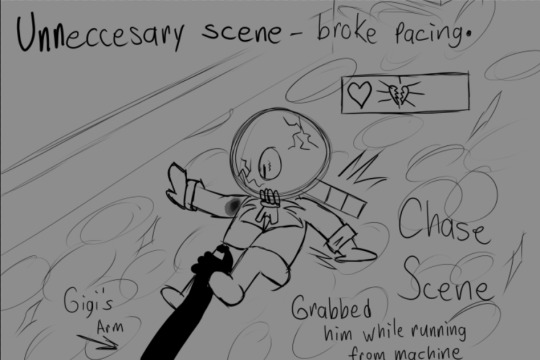
This was one of the scenes that I mentioned that was giving me trouble! It was just after the final machine was completed and I was having trouble writing the chase sequence - I ended up going to Reddit threads for writing advice, and then scrapped the scene altogether.
Overall, it was breaking the pacing and believability to have Gigi grab Rodger here and THEN having him get up and run from Glisten. Given the speed of Glisten, he would not have had more than two seconds to try and run away before Glisten ended up pouncing on him, and I wanted the confrontation to be in view of the elevator and closer to when it closes. Plus it gave me a little bit of Chekov's Gun with Boxten!
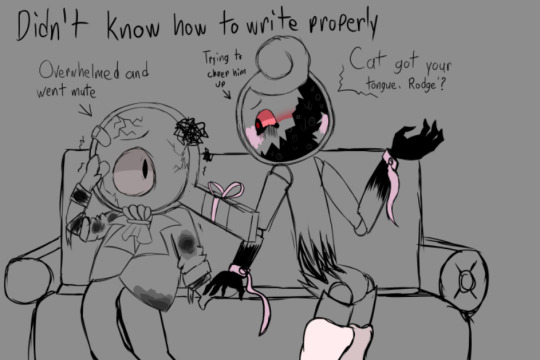
So for this, it wasn't just one scene, but things I was trying to sprinkle in through the whole fic. I know I've mentioned before that I HC Rodger as emoting a lot more expressively in both his mannerisms and also in literal cartoon emotes, and then if he truly gets overwhelmed, he'll end up going mute and letting his natural physical expressiveness do the talking until his mind calms down (selectively mute Rodger HC :)). Truthfully I really wanted a scene where Glisten would get to basically monologue lol.
Unfortunately, whenever I kept rereading wherever this popped up, it just... wasn't working as much as I wanted to, and kept feeling unnecessary and pushed in. Eventually I scrapped the emotes and the idea of him getting overwhelmed in the epilogue, but I imagine Glisten would've tried to comfort him a little when he realised what was happening before the monologue started. Thankfully (or unfortunately given how you see it) he did actually get to have most of the dialogue in the epilogue, I just kept Rodger's dialogue short because of him LITERALLY *JUST* waking up from almost dying and trying to process everything.
♤~~♡~~♤
Scrapped Epilogue Dialogue (Reason: Out of Character, didn't fit with established dialogue)
<Pink text is what's already in the fic. Plaintext is what was scrapped>
"and I have Toodles to take care of, and- and everyone is relying on me to fix this mess, and it isn't even a definite that we'll find my equipment quickly!! I can’t just accept this and start planning for the long term!”
“You can because you are STUCK here.” Glisten hisses out, leaning closely to Rodger again even as the other rears back. "You know, none of them came out of the elevator when you were stalled to help."
The mirror's eye has reddened again as he speaks, his tone somewhere between desperate and crazed.
"They just *stood there.* Watching and panicking as if they couldn't do a thing. The most they did was throw a *wrench* into me. Not even when you were five feet away being attacked by Boxten. They had a few seconds. They could have run out."
The way Glisten says that so vehemently, his fingertips digging into the couch cushion, is unsettling to hear. Rodger had honestly never heard him speak so bitterly about something.
"What are you implying he-"
"What I'm implying should be obvious, Detective."
Glisten gives Rodger a long look, almost as if looking through him at something else.
"They left you. They left us," Glisten whispers, "You- you said Vee didn't trust me, and- you know she can make some rash decisions, maybe- maybe she made them stay back because there was so little time left..."
A small, delirious giggle emits from the mirror, sending a chill up Rodger's spine as the detective's eye darts around for anything he could use to...
To do what?
I don't know.
You can't hurt him.
I know.
You can't outrun him.
I know.
So what would you do if he starts getting out of control again?
I don't know.
"And- and I don't *blame* her, not risking another Toon to save you, and it's- it's my fault that that decision had to happen in the first place, my fault, if you'd been a few seconds earlier, you'd-" ...
♤~~♡~~♤
Aaaand there's some deleted / scrapped bits! Some bits could probably have been executed if it wasn't already so long and I knew how to fix them sounding boring or non-believable, but then there were some bits that just didn't fit with the character personas already established. Deleted scenes my beloved <3
#player rambles#my writing#art#doodles#dandys world#glisten dandys world#twisted glisten#rodger dandys world#dw rodger
55 notes
·
View notes
Text
Alright I can't finish this all in one sitting, but here's at least a bit of.... something? A word vomit? A prelude to smut about the eroticism of the machine? For all you robot, mecha, and spaceship fuckers out there. @k1nky-r0b0t-g1rl that means you
Pappy always said that manufacturing biological transportation was nothing knew. I mean, shit, humanity's been breeding horses for how long? To him, not much was novel about what was going on in the shipyards way out by Neptune when I was a kid.
But Pappy didn't know a lot of things. And he certainly didn't meet Roseanna.
The Federation Navy had experimented with biologics for decades. The idea was to create self regenerating ships- something to interface with the hull, move the new titanium plates and particulates into place, have a living, growing mass interfacing with the steel so that the ship didn't have to head all the way back to the yards to patch up after every dogfight.
The first generation... worked. With a full time crew, that is. Full time people on deck jabbin the rigid, chitonous interface with the hull full of growth hormones to get them to set just right. Full time onboard bioengineers to compute what signaling cocktail ya need to hit 'em with to get it to grow back right. Skilled onboard technicians to shave back the chitin when it tried to overgrow the titanium, and slap some new cells in to seed the process in heavily damaged areas. Less input material, less time in the yards, but far more manpower. Great for a Federation cruiser on deep space peacekeeping missions. Far too complex for small craft. Right?
Until some bastard put brains in 'em.
Well. A lotta suits would say that they weren't brains. They were a diffuse network of sensory neurons and ganglia, living inside the body of the ship, integrating signals from a skin of alloyed metal and fibrous protein, calculating power draw too and from various components, and integrating with the mechanical and electrical components of the ship to precisely manage the "wound healing" process of the vessel. And of course, it just so happened that one of those ganglia was larger and more complex than the rest of them, and it just so happened that the computer interfaces with this ganglia exhibit complex, thinking behaviors on the level of human cognition, and it just so happens that most pilots and navigators reported them developing their own personalities.....
But of course, the Navy didn't want anyone to have some kind of pesky empathy in the way of their operations. And they certainly didn't want anyone side eyeing the rate at which they disposed of the damn things, and let them suffer and rot after disposal. So as far as the official record was concerned, they didn't have brains.
Like most people in the belt, I found Rosie on a... unsponsored field trip to the Neptune scrap yards. She wasn't a ship then. She wasn't much of anything. Not much more than a vat with the central ganglia and just barely enough of the stem cells needed to regrow a network. But I took her all the same. Brains were valuable. Few pilots outside the Navy had them back then. Nowadays, a black market for "brain seeds", a cocktail of neuronal stem cells and enough structural stem cells to grow your own into the chassis of your ship. They were pumpin' em out, and leaving them to die. It was cruel. They may be vehicles, but they're a livin' being too.
But I digress. I'd never do that to Roseanna. I make sure she gets proper care. And for a good, proper, working ship? That includes some good, proper work.
The asteroid we were docked in was one of my usuals- good bars, nice temp quarters, nice views of the rock's orbiting twin, and a spacious hanger for Rosie to rest in. The chasiss I had imprinted Roseanna to was a 40-meter light skipper, with some adjustments for handling deep space trips. It was pretty much the smallest thing you could actually use to live and work for long periods of time, but it got the job done. The angular design made the entire ship look like a wedge, or the blade of a bulky dagger. It didn't hurt that each bottom edge was fortified with a sharpened titanium blade, turning the entire sides of the ship into axe-like rams.
Those would probably come in handy today.
I approached Roseanna on the catwalk above her, marveling her alloyed scales. I could almost see her shudder in anticipation as my footsteps vibrated through the air above her. I took the steps down, and hit the trigger to open her top hatch.
When the news got out of the Navy scuffling with a rebelling mining station, an electric air raced across the station. Some went about their day as normal. Some resigned themselves to picking at the leftovers after the dust had settled. And some, like me, knew that they could get the finest pickings.
I strapped in to the pilot's seat like it was an old boot.
"Welcome, Captain Victoria."
Rosie could talk, but more often than not, she chose not to. But she understood me just fine. Most of our communication took place using her three prerecorded lines- her welcome statement, affirmative, and negative- as well as the tiny screen showing a small, emoticon face. Many pilots chose to give their ships an elaborate render, but Rosie preferred it this way. It was the first face I gave her, from somewhere out of the scrap heaps, and she refused any offer I made to upgrade. Secretly, I was overjoyed. To me, that was her face. That was her voice. And it was beautiful to see her true self through them.
I brushed my hands across her paneling. Across the switches, the hydraulic controls for the plasma fuel, the steering, the boosts, the comms channels. The thing with biologics was that you were still the pilot. For whatever reason, they hadn't quite gotten to the point where the brains could take over their own piloting. My personal opinion was just that their personalities lacked the ambition to. But whatever reason that was, the best pilots were still the ones that knew both their ship, and the ship's brain. And me and Rosie? We knew each other well.
As my fingers touched the brushed aluminum controls, rimmed with chitinous layers rooting them into the ship, I could feel the walls around me holding their invisible breath. "Do you know what we're doing today, Rosie?"
Her tiny panel flickered on. ...?
"We got a scrap run."
^_^
:)
^_^
Her panel flicked between various expressions of excitement. My finger quivered on the main power, holding for a moment before flicking it on. The primary electronics of the ship hummed to life, and what Rosie controlled pulsed with it. My hands moved across the main functional panels- main hydraulic plasma valve, exhaust ports open, and finally, flicking the switch the start the plasma burner.
My hands gripped the steering. The hanger's airlock doors opened in front of me. My neck length hair started to float as the station's gravity shut off. I hit the switch to unlatch from the supports above. For a moment, we hang there. The dull crackle of the idling plasma burner is the only sound that resonates through Rosie's hull.
Go time.
I punch the boost.
#eroticism of the machine#robot girl#mecha girl#spaceship girl#the fuck do I even tag this LOL#yall gotta tag this and make sure it gets to the right spaces for me okay
280 notes
·
View notes
Text
Closing Time
Summary: For pricklenettle, Phandom Holiday Truce 2024
With twenty minutes left in his shift, an unseen ghost shows up to make his night harder. Tucker does not get paid enough for this.
Word Count: 2074
Also on AO3 and Fanfiction.net
Note: Happy Truce! This story is for @pricklenettle. I went with the Prompt 2: Danny being a creepy, mysterious fellow somewhere normal like a gas station. Prompt 5 inspired me to have Tucker be the pov character, though.... well, you'll see. 😉
Enjoy!
Just twenty minutes. Twenty minutes before closing time.
Tucker sighs, repeating the words in his head as he sweeps the front of the supermarket. The broom’s bristles scrap against the floor, the sound grating against his ears. Ten feet away, his manager surveys the square of self-checkout kiosks. One lone customer, a middle-aged man, swipes his chips and soda. The machine chimes harshly as it processes the man’s credit card.
The boy lifts one hand to massage his forehead. Just twenty more minutes.
The shopper exits passed Tucker and the teen’s gaze follows, trailing to the wide glass window, to the pitch-black outside. The doors slide open, the sound of rain crashing through the front with a spray of cold droplets.
Tucker winces at the sensation. Please, please let it stop soon. Fervently, he begs in his head. Please let it stop before he has to run to the bus stop.
“Go sweep the produce section.” His manger’s nasally voice cuts through the silent pleading.
With a nod, the teen complies. He pushes the broom’s long head around the banana stand. The bristles scrape harshly as the lights illuminating the vegetable stands buzz sharply. And Tucker again rubs his forehead, gritting his teeth at the building headache.
Those stupid lights, this stupid broom. If his boss wouldn’t give him crap about it and would just let him wear headphones at work….
Tucker hums under his breath, repeating the chorus to his favorite Dumpty Humpty song in his head. Normally, that is a decent distraction from the overstimulating sounds. But this night….
The pounding of rain on the roof crescendos. Tucker shivers, suddenly cold. A draft blows through, from the outside doors at the front of the store, he assumes. The chill tickles his nose and he sneezes. Tiny, wet drops spray on his face.
Great. The boy huffs, wiping his nose with the back of his hand. He’s getting the cold Danny has too, isn’t he?
At least he can go home soon and collapse on his warm bed.
Tucker goes back to sweeping, humming the same Dumpty Humpty song. He sweeps up little bites of onion peel, fallen leaves from the poinsettia display, dried mud tracked in on someone’s boots. He moves in front of the carrots and cucumbers, wrinkling his nose as water mists over the produce and sprays him.
The teen comes to the end of the produce section, to the first fridge of meat. He surveys the pork chops approvingly. Oh, those ones are on manager’s special. Maybe he should-
Suddenly, the sound of a cough cuts through his thoughts. Tucker looks up, drawn to the noise.
Two aisles over, someone about his height in a red hoodie stands with back facing him. Huh? How hadn’t noticed that person before? The clink of cans shifting in a pile sounds as they pick up a can of soup.
Tucker goes back to sweeping, eyes fixed on the head of the broom as he carefully maneuvers it between the horizontal display fridge filled with pork ribs and a shelf with an offering of barbecue sauces.
The heavy thump of a can falling and Tucker’s head jerks up again. The person in the hoodie is gone, a can of chicken noodle soup rolling across the floor.
Brow winkling, the teen approaches. He picks up the luckily undented can, returning it to the display. His head tilts, peering down the pointedly empty aisle. Where did the person in the hoodie go?
Before Tucker can contemplate the mystery, the intercom crackles. “Clean up! Aisle 10!”
Tucker sighs, rolling his eyes exacerbatedly. Really? This is the second time this shift. Please don’t be throw up again, he mentally begs. Still, he carries the broom back to the supply closet near the restrooms, collecting the bucket and mop.
The teen jerkily pulls the yellow monstrosity through the store. One of its wheels refuses to spin. “Come. On.” He mutters under his breath, annoyance growing.
He passes the lunch meat and the cheese, the butter and eggs. Approaching the aisle in question, Tucker takes a breath, preparing himself for what will hopefully be a small mess. He rounds the corner and-
Milk… all over the floor. The teen’s jaw drops. Half the length of the aisle, a good twenty feet section of the floor is covered in the white liquid.
“H… how?” He can’t help but stutter. How could someone even manage to spill this much milk?
Eyes blown wide, Tucker approaches the nearest jug. Tentatively, he prods it with his shoe. The plastic crunches at the touch, jagged cracks scrapping against each other. It looks almost shattered…as if dropped from a great height.
His eyes trail over the scene once more. A dozen more crumpled jugs litter the floor, their contents all explosively dispersed.
But…. How? How could one person do this? A flicker of unease leaps in his stomach. If he didn’t know better, he would think it was the Box Ghost’s doing. Expect these are plastic jugs, not rectangular cartons. No boxes have been touched, not cardboard the cartons of eggs come in, the microwave dinners, or the sticks of butter. And most tellingly, there are no shouts of beware.
Tucker’s nose wrinkles. It would be just his luck for Boxy to show up for the end of his shift.
The teen shakes his head, dislodging the thought. That hypothetical doesn’t matter right now. He frowns hopelessly down at the now quite insufficient mop. He’s going to need those blue absorbent puppy pads. A lot of them.
Tucker turns around, leaving the mop and bucket and starting back towards the storage room. He passes the butter and eggs again. The sign for the bathroom looms in front of him. He quickly comes to the open doorway, across from the clearance rank, and-
A puff of cold on his neck. The boy stiffens. A low whisper echoes to his right, behind him. Movement out the corner of his eye, a flicker of maroon red and neon green.
Tucker freezes, head jerking to the side to look. But… nothing.
There is nothing beside him, just the freezer of meatballs and chicken nuggets.
The lights above flicker and pop, flashing brightly at the same another whisper crackles, on his other side and full of static. Tucker’s head jerks to the sound, catching another flicker, this one of something black. His body follows the movement of his gaze, turning back the way he came.
No farther spills, no customers, no annoying boss. No one to mutter or dart passed him. The walkway is the same.
Except… a spot of neon green.
Annoyance swirling in his gut, Tucker marches up to the spot. He kneels and his brow furrows at the object. A tissue, stained with globs of glowing green.
“Freaking ghosts.” The teen curses under his breath. Of course! Of course it’s a ghost.
He picks up the tissue between two fingers, nose wrinkled in disgust. What is this? The ectoplasm looks sticky and wet, glowing between the folds of the crumpled kleenex. Like some kind of ghostly booger. From what? A ghost of the common cold?
“The store closes in five minutes!” His boss’s false cheery voice cuts through the scene. “Please bring your purchases to the front.”
Tucker groans at the words, standing. Ghost or no, he still has an aisle to clean. He hurries to the storeroom, grabbing a wad of absorbent pads. He manhandles the big black trash can with wheels, pushing it out of the closet and through the open doorway.
Then a flash of green light. A crash reverberates around the corner, back in the milk aisle.
Unthinking, Tucker takes off running. He rounds the corner, the spilled milk puddles appearing in front of him once again. A burst of cold and his legs fly out from under him.
The teen falls, landing heavily on his behind. Sudden adrenaline pounds his heart, the sound deafening in his ears. He shivers, not just from any dread but… the cold. His hand reaches for the white covering the floor, goosebumps prickling his skin. It’s frozen.
Shakily, Tucker puts his hands under him. He rises to his feet; thank goodness he’s not hurt any more than his sore tailbone. Still, his eye dart side to side, on alert.
“Look.” The teen sighs, annoyance growing. “Whoever you are, just-”
From outside, thunder crashes. The building shakes with the sound. The lights flicker, blinking out across the store.
Great, they just lost power. It’s a fleeting thought. Except-
His eyes widen at the freezers, still humming. Their fluorescent white light eerily illuminate the aisle.
“Alright.” The boy mutters, taking a step back from the slippery floor. “Dude, just turn the light back on so I can clean this.”
Ominous whispers answer, the words lost to static. To his side, a shadow passes over the freezer’s light.
Tucker turns, fumbling in his pocket. “You know what, I don’t care about the lights!” Come on. Come on. Where is that wrist ray? “Just go!”
Another boom of thunder rattles the air. The PA system shrieks, a deafening dial tone. The boy grimaces, covering his ears. Again, a shadow flickers out the corner of his eye.
The sound cuts out. The teen jerkily swivels to face the flicker, pulling out a lipstick blaster. “Don’t make me-“
The freezer door behind him slams open, the force of the glass on his back sending him to the ground. The blaster goes off, the laser sailing through the air. Harmlessly, it pings off a bakery display. Meanwhile, Tucker’s momentum sends him sliding across the slick floor on his front.
“Dude, I just want to finish my shift and go home!” The teen complains, slamming into said mid-aisle shelf.
He rolls to his side, groaning. Those bruises are going to hurt in the morning.
Neon green streaks across his vision. Again, Tucker shoots. Again, the laser flies free. And still, it fails to impact.
In response, more glass doors fling open. Three shelves collapse, dozens of frozen meals crashing onto the floor.
“Not my Hungry Man too!” The teen cries.
Back pressed against the wooden bakery shelf, Tucker pushes himself up to sit. With frustration-gritted teeth, he holds the blaster in front of him.
Static pops, filling his ears as the hum of the freezer crescendos. The ghostly fluorescent light flickers bright and dimmer. But… no hint of shadow, no ghostly green.
Eyes still intently focused ahead, Tucker reaches for his PDA. “That’s it. I’m calling Danny.” He scowls, finger over the button. “He can deal with you-“
The PDA sparks, to the technogeek’s horror. He flings it away. At the same time, a screeching reverberates, like long skeletal fingers scratching styrofoam. A milk carton rises from the open fridge. The teen stares with narrowed eyes as the plastic warps. It explodes. Drops of white liquid hang in the air for a drawn out second, before flinging across the room.
Something in Tucker snaps. He’s cold, tired, and bruised. His head hurts. His shift is almost over. Enough is enough!
“Seriously!?” He shouts, frustration giving way to rage. “I have to clean all this up?!”
In one surprisingly fluid motion, he stands. The shadows hiss, two glowing green orbs flashing into sight. They linger, just a second. But it’s enough.
Tucker shoots the blaster. And it impacts.
A pained yelp sounds. The darkness solidifies, person-shaped between one blink and the next. The green orbs, eyes, widen.
A flash of light blinds Tucker. In the next second, the store’s lights are back. The freezer doors all slam closed.
And a boy in a red hoodie crumples, falling to his knees five feet in front of him.
“Wha- Tuck?” The boy blinks, looking up.
Tucker’s jaw drops. “Danny?”
“I was in bed. What? How did I get- Acho!” A sneeze interrupts, Danny whipping glowing green snot away with his sleeve. “How did I get here?”
Tucker stares, mind churning with surprise. Then… understanding. “You!” He points accusingly. “You did this!”
“What?” Dazedly, the half ghost looks over the destruction.
“And you were, what? Sleeping haunting?!” His hands lift, exacerbated. “This is gonna take an hour to clean up!” He marches forwards, grabbing the mop and bucket, and shoving the handle at his friend. “You’re doing it!”
“But…but…” Danny stutters, blinking disbelievingly at the mess
Still, Tucker stomps away. He doesn’t get paid enough for this.
Note: Thanks for reading! I hope you enjoyed.
I debated whether to end it with Tucker storming off or if I should show more of the aftermath but decided the quick ending worked best with the prompt I was going for. Rest assured though, like two minutes after storming off, Tucker comes back and feels really bad about losing his temper. There are mutual apologies as both clean up. Danny flies Tucker home (yay for not having to wait for the bus in the rain!). And the next day, they're laughing about the entire thing.
62 notes
·
View notes